The "Conflict" was known in American newspapers and the new medium of television news as the "KOREAN WAR". The problem was there wasn't any "Korean War". It was really only a "United Nations POLICE Action".
This "Police Action" pitted South Korea, the United States, the United Kingdom, Canada, Turkey, Australia, the Philippines, New Zealand, Thailand, Ethiopia, Greece, France, Columbia, Belgium, South Africa, the Netherlands and Luxembourg on one side. Against North Korea, China and the Soviet Union on the other side.
It ended on July 27th, with an "Armistice"being signed by all parties. It is still in effect today dividing the Korean Peninsula at the 38th parallel. There has never been a "Peace Treaty" between the two Korea's, or with the United Nations
Nothing was ever really settled, but that "Armistice" did permanently create the countries of North and South Korea with a demilitarized zone between them guarded still by United Nations troops.
The above is the reality, but this article isn't about that reality. It's about what those on the "Home Front" saw on their motion picture screens during that war that wasn't a war and afterwards about "The U.N. Peace Action". A means of propaganda mixed with entertainment.
THE NORTH AND ITS ALLIES
The problem with getting information on motion pictures made by the "Democratic People's Republic of Korea (North Korea)", is that few movies leave the country. We know the titles of five motion pictures, one supposedly a documentary, made and released during the "Police Action" between 1950 and 1953, but have no information available as to the nature of their stories. The five titles in English are "Righteous War", "The Blast Furnace", "Guards on the Crossing (The Frontier Guards", "Boy Parisians" and "Again to the Front". There is no question that these films were propaganda made for the North Korean people. The first North Korean motion picture released after the "Armistice" was obviously war related "The Combat Unit of a Fighter Plane".
To date there are only two other movies released in North Korea about the period. The picture "Wolmi Island", released in 1982, is currently available on line with subtitles.
The events on that island, located less than three quarters of mile off the North Korean coast, were horrific and 32 years later perfect for propaganda. On September 10, 1950 the United States attacked the army garrison located on Wolmi Island. For five days 95 napalm bombs were dropped not only killing the North Korean soldiers stationed there, but hundreds of civilians.
In 1978 the first part of a 20 plus hour mini-series lasting into 1981 was released. The film's title in English was either "Unsung Heroes", "Unknown Heroes", or the more literal translation "
Nameless Heroes". This was a spy thriller about a Korean expatriate living in the United Kingdom before the start of the "War". He was given orders to go to Seoul, South Korea to gather information about the "United States Forces Korea" stationed there.

The film was based upon actual events and some of the names used such as John Foster Dulles are real. While others are fictitious. Apparently the real spy's information helped the North Korean's learn of allied plans during the conflict, However, this story also implies that his information led to the final North Korean advance. Which, according to the film, forced the United States and the other NATO Allies to realize their fruitless position and request negotiations for peace with them. The propaganda message being how superior the forces of the Democratic People's Republic of Korea were over those of the United Nations.
The North's ally the "Soviet Union" apparently never made a specific motion picture on the "Police Action". However, the motion picture industry of "The People's Republic of China" did, but not until 1956.
The picture was "Shangganling" aka: "The Battle of Shangganling" or "Battle on Shangganling Mountain". The motion picture was pure propaganda about the actual "Battle of Triangle Hill". "Shangganling" was the Chinese name for this "Hill" which was in no way a "Mountain".
Looking at the actual facts of the action. The battle started on October 4, 1952 and did not end until November 25th. The objective like many in the Korean conflict was to take and maintain control of one hill. The NATO forces used were two United Nations composite infantry divisions with United States Air Force support/ They were up against the 15th and 12th Corps of the People's Republic of China. Why this story made for a good propaganda motion picture. Is that after 42 days and with superior forces and equipment. The U.N. decided the casualty losses were too great to sustain the battle and pulled out giving "Shangganling" to the Chinese. Those looses were 468 United States soldiers killed, 1,174 wounded and one man captured. The South Korean figures were 1,096 killed, 3,496 wounded and 97 missing in action. While on the Chinese side the figures were 4,838 killed, 6,691 wounded.
The motion picture's tone and construction is compared to the 1959 American film "Pork Chop Hill" which I will mention later, but this Chinese film came out three years earlier. So perhaps the reverse in in order.
The actual battle and the motion picture recreation centered upon "The People's Volunteer Army". Which was the Propaganda name of the army during the action. Both reflect the Chinese Communist tradition known as:
die for the sake of motherland heroism
The above photo from the movie is supposed to be the real Wang Qingzhen. Who was one of the "Health Workers" of "The People's Volunteer Army" in the actual battle. The English Language website "Best China News" has her story in an article written in broken English at:
http://www.bestchinanews.com/History/9727.html
I will warn my reader the link's article has a propaganda tone, but is interesting in content.
On January 19, 2011 at a White House dinner for Chinese President Hu Jintao. Invited to perform was World Renown Chinese Concert Pianist Lang Lang. On piece of music he chose to perform was a popular one in his native China, but it caused controversy and embarrassment for the Chinese President. The piece of music was "My Motherland" the theme song from the motion picture. The lyrics contain the line:
Which was a direct reference to the United States Army during the U.N. Police Action. In a statement after the event Lang Lang stated he had no intention of insulting either President Obama, or the United States. The song was just a favorite of him since childhood.
The power of propaganda related to this 1956 motion picture lives long.
In 1976 China released a motion picture entitled "Power Fighter in Vast Sky" also about the conflict, but I couldn't find any specific information about the picture. That didn't hold for their third and final film to date about the Korea entitled "Assembly" from 2007.

"Assembly" follows the fictional life of one Chinese man, "Captain Guzidi", the starts when he was part of the 139th Regiment of "The People's Liberation Army" during World War 2. The website for the British publication "The Guardian" has a very good review of the film:
Remove the "patriotic rhetoric" and the picture could have been about American's who died on the Normandy beaches, or the French and British at Dunkirk. As to that rhetoric I will be addressing some allied uses later.
THE SOUTH AND ITS UNITED NATION ALLIES
Taking a look at the Republic of South Korea. Between 1950 and 1953 there were only fourteen motion pictures made and all are considered lost. What were the titles, or subject matter of these films apparently are also unknown. Compared to the North pushing out its propaganda features. The South's film industry had stagnated after the Second World War.
In 1955 South Korean director Lee Kang-cheon released his motion picture "Piagol" about the war. This first South Korean motion picture since the "Armistice" was considered Pro-Communist and banned in the South. It would be six years before another film on the "Police Action" was made.

Starting in 1961 with "Five Marines" about a mission into the North and the valiant deaths of four of the five. The South Korean film industry would make a total of 17 motion pictures through 2016 using the War as a back drop. The second film to be released in this group was "The Marines Who Never Returned" in 1963. A squad of Marines fight the Chinese in the North and one by one are killed fighting Communism.

Also in 1963 was the "Red Scarf" aka: "Red Muffler" aka: :Operation Air Raid: Red Muffler". This motion picture was about members of the 10th Fighter Group of the South Korean Air Force, This typical love in war plot takes place in 1952 with young men flying "Sabre Jets" against North Korean Soviet MIG-15's.


The "Red Scarf" has a very similar story line to the American motion picture from 1958 "The Hunters" starring Robert Mitchum and Robet Wagner. Which was about the 51st Fighter Interceptor Wing during Korea..
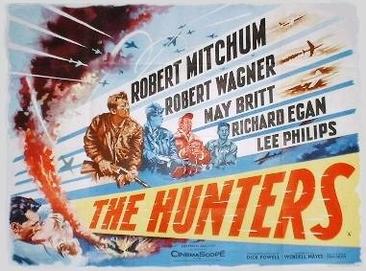
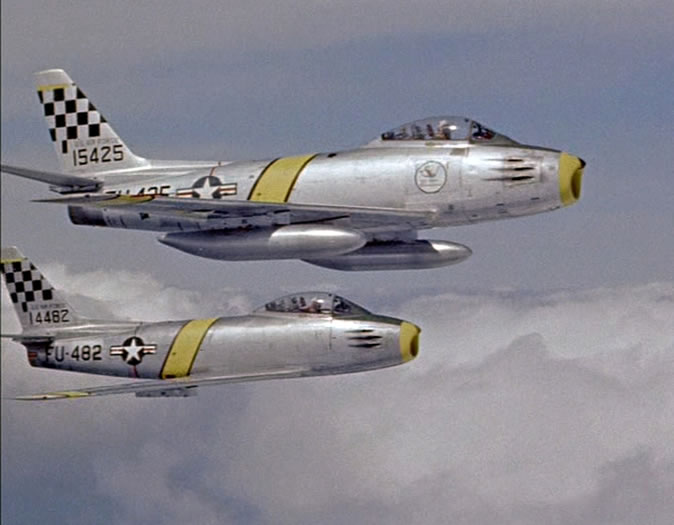

I just want to mention five more films in this South Korean group. The first is "Nambugun: North Korea Partisan in South Korea" released June 2, 1990. This feature was based upon the true story of "Lee Tae" a Korean War Correspondent. The following is translated from a Korean website describing the story:
1991's "Silver Stallion" takes an ugly look at the United Nations troops that enter a Korean village and the rape of a young women. The women and her son are ostracized by her own people and she turns to prostitution at a United Nations base across the river from the village.
http://www.bestchinanews.com/History/9727.html
I will warn my reader the link's article has a propaganda tone, but is interesting in content.
On January 19, 2011 at a White House dinner for Chinese President Hu Jintao. Invited to perform was World Renown Chinese Concert Pianist Lang Lang. On piece of music he chose to perform was a popular one in his native China, but it caused controversy and embarrassment for the Chinese President. The piece of music was "My Motherland" the theme song from the motion picture. The lyrics contain the line:
We deal with wolves with guns
Which was a direct reference to the United States Army during the U.N. Police Action. In a statement after the event Lang Lang stated he had no intention of insulting either President Obama, or the United States. The song was just a favorite of him since childhood.
The power of propaganda related to this 1956 motion picture lives long.
In 1976 China released a motion picture entitled "Power Fighter in Vast Sky" also about the conflict, but I couldn't find any specific information about the picture. That didn't hold for their third and final film to date about the Korea entitled "Assembly" from 2007.

"Assembly" follows the fictional life of one Chinese man, "Captain Guzidi", the starts when he was part of the 139th Regiment of "The People's Liberation Army" during World War 2. The website for the British publication "The Guardian" has a very good review of the film:
Assembly (124 mins, 15)
Directed by Feng Xiaogang; starring Zhang Hanyu, Deng Chao, Yuen Wenkang, Tang Yang
Feng Xiaogang's Assembly is a vigorously staged war movie that has been a deserved success in China. The central character is Guzidi, a brave captain of peasant stock who has fought for the communist army against the Japanese invaders and the nationalists since 1939 and is the only survivor of a delaying action that saves a whole regiment in the last days of the Civil War in 1948.
When his dead comrades receive no recognition for their sacrifice, he fights to get them a memorial. As a result, he remains in the army to be seriously injured for the second time serving with the North Korean army in 1952. Ironically, on both occasions he's wearing the enemy's uniform. This is a film that eschews triumphalism and the customary patriotic rhetoric. Its subject is friendship, respect for individuals and the quest for justice and historic truth.https://www.theguardian.com/film/2008/mar/09/drama.worldcinema
Remove the "patriotic rhetoric" and the picture could have been about American's who died on the Normandy beaches, or the French and British at Dunkirk. As to that rhetoric I will be addressing some allied uses later.
THE SOUTH AND ITS UNITED NATION ALLIES
Taking a look at the Republic of South Korea. Between 1950 and 1953 there were only fourteen motion pictures made and all are considered lost. What were the titles, or subject matter of these films apparently are also unknown. Compared to the North pushing out its propaganda features. The South's film industry had stagnated after the Second World War.
In 1955 South Korean director Lee Kang-cheon released his motion picture "Piagol" about the war. This first South Korean motion picture since the "Armistice" was considered Pro-Communist and banned in the South. It would be six years before another film on the "Police Action" was made.

Starting in 1961 with "Five Marines" about a mission into the North and the valiant deaths of four of the five. The South Korean film industry would make a total of 17 motion pictures through 2016 using the War as a back drop. The second film to be released in this group was "The Marines Who Never Returned" in 1963. A squad of Marines fight the Chinese in the North and one by one are killed fighting Communism.

Also in 1963 was the "Red Scarf" aka: "Red Muffler" aka: :Operation Air Raid: Red Muffler". This motion picture was about members of the 10th Fighter Group of the South Korean Air Force, This typical love in war plot takes place in 1952 with young men flying "Sabre Jets" against North Korean Soviet MIG-15's.


The "Red Scarf" has a very similar story line to the American motion picture from 1958 "The Hunters" starring Robert Mitchum and Robet Wagner. Which was about the 51st Fighter Interceptor Wing during Korea..


I just want to mention five more films in this South Korean group. The first is "Nambugun: North Korea Partisan in South Korea" released June 2, 1990. This feature was based upon the true story of "Lee Tae" a Korean War Correspondent. The following is translated from a Korean website describing the story:
In 1950, the reporter Lee Tae-tae joined the underprivileged mountain. Lee, who was injured when the Blue Dragon operation collapsed and was chased by tobeoldae, falls in love with Park Min Ja, who was nursing herself. Winter is deepening, and Ithai's platoon participates in battle battle. There he meets the poet Kim Young and he talks about the futility of war between his own people. The southern army, driven by the continuing battle, is pushed to Mt. Jiri and meets with the imaginary Lee Hyun-sang, and Lee is surprised by the bravery of Kim Hee-sook. From this time on he becomes a member of the political party. While the news of the ceasefire is heard, the atmosphere of the crews becomes turbulent and the southern troops are pushed to the edge by the cold and hunger. At last, the last battle of the devil is going on and he falls in the snow and becomes a prisoner of the troupe. His long-suffering partisan struggle also ended.https://www.themoviedb.org/movie/79894-nambugun/changes
1991's "Silver Stallion" takes an ugly look at the United Nations troops that enter a Korean village and the rape of a young women. The women and her son are ostracized by her own people and she turns to prostitution at a United Nations base across the river from the village.
On February 6, 2004 a film set during the Korean War became the all time biggest box office motion picture made and released in South Korea. "Taeguki: The Brotherhood of War" opens with a elderly man being notified that his remains have been located at a site for a war memorial and the question is asked: How can this be?
Flashbacks will tell the story of two brothers living peacefully together with their family in 1950 South Korea. On June 25, 1950 the North invades the South and the two boys are forcibly conscripted into the the South Korean Army. They find themselves part of the First Infantry Division pushing into the North.
The elder brother "Lee Jan-tae is told that if he earns the highest medal of the South Korean Army the "Taeguk Cordon of the Order of Military Merit". His younger brother "Lee Jan-seok" will be sent home. The audience watches "Jan-tae" become a vicious, unfeeling killing machine to earn the medal.
The climax of the movie comes in a fierce battle with "Jan-seok" being wounded. His older brother, "Jan-Tae", makes "Jan-seok" escape to safety. The audience next observes "Jan-Tae" turn a machine gun on the overwhelming advancing North Koreans and dying while saving his brother. As the South Korean position is overrun by the North.
The above scene is reminiscent of the ending to 1943's "Bataan". Where Robert Taylor, the last remaining member of his army squad, turns a machine gun on the advancing Japanese dying in a heroic propaganda style ending to that American war film.
The motion picture was nominated for and won awards in four Asian film competitions. These were the "Baeksang Arts Awards", the "Grand Bell Awards", the "Blue Dragon Film Awards" and the "Asian Pacific Film Festival".
April 27, 2011 saw the release of "Jeokgwa-ui Dongchim (Sleeping with the Enmeny)" aka: "In Love and War". The screenplay writer Bae Se-young uses a story her grandmother told about life in her village of Pyeongtaek during the war. When a group of soldiers from the "North Korean People's Army" stayed for a couple of days and one touched by the villagers decided to remain with them. This incident ended in a tragic real life love story for the young man and a village women.
The picture's director Park Geon-yong stated, on April 22, 2011, that the film's :
"Operation Chromite" was released July 27, 2016 and is a South Korean fictionalized look at the CIA/US Military Intelligence gathering operation code named "Trudy Jackson". The picture's title is misleading as it does not actually deal directly with "Chromite". Which was the code name for the future "Battle of Incheon". An amphibious invasion into North Korea from September 15 through September 19, 1950 that involved 75,000 troops and 261 naval vessels.

Flashbacks will tell the story of two brothers living peacefully together with their family in 1950 South Korea. On June 25, 1950 the North invades the South and the two boys are forcibly conscripted into the the South Korean Army. They find themselves part of the First Infantry Division pushing into the North.
The elder brother "Lee Jan-tae is told that if he earns the highest medal of the South Korean Army the "Taeguk Cordon of the Order of Military Merit". His younger brother "Lee Jan-seok" will be sent home. The audience watches "Jan-tae" become a vicious, unfeeling killing machine to earn the medal.
The climax of the movie comes in a fierce battle with "Jan-seok" being wounded. His older brother, "Jan-Tae", makes "Jan-seok" escape to safety. The audience next observes "Jan-Tae" turn a machine gun on the overwhelming advancing North Koreans and dying while saving his brother. As the South Korean position is overrun by the North.
The above scene is reminiscent of the ending to 1943's "Bataan". Where Robert Taylor, the last remaining member of his army squad, turns a machine gun on the advancing Japanese dying in a heroic propaganda style ending to that American war film.
The motion picture was nominated for and won awards in four Asian film competitions. These were the "Baeksang Arts Awards", the "Grand Bell Awards", the "Blue Dragon Film Awards" and the "Asian Pacific Film Festival".
April 27, 2011 saw the release of "Jeokgwa-ui Dongchim (Sleeping with the Enmeny)" aka: "In Love and War". The screenplay writer Bae Se-young uses a story her grandmother told about life in her village of Pyeongtaek during the war. When a group of soldiers from the "North Korean People's Army" stayed for a couple of days and one touched by the villagers decided to remain with them. This incident ended in a tragic real life love story for the young man and a village women.
The picture's director Park Geon-yong stated, on April 22, 2011, that the film's :
main purpose is to highlight the plight of the most vulnerable people in the Korean War - innocent civilians
"Operation Chromite" was released July 27, 2016 and is a South Korean fictionalized look at the CIA/US Military Intelligence gathering operation code named "Trudy Jackson". The picture's title is misleading as it does not actually deal directly with "Chromite". Which was the code name for the future "Battle of Incheon". An amphibious invasion into North Korea from September 15 through September 19, 1950 that involved 75,000 troops and 261 naval vessels.

In the center of the above picture is Northern Ireland actor Liam Neeson as "Douglas MacArthur". MacArthur was forced to get needed intelligence of the area around the port city of Incheon and a U.N. Intelligence group was sent into the city. That was under the command of "Captain Jang Hak-Soo" portrayed by Lee Jung-jae shown in the center of the above picture. "Jang" was a former North Korean Army Officer who defected to the South after witnessing his own father executed by fellow Communist Officers. The third actor on the far right is Lee Beom-soo as "Commander Lim Gye-jin". "Gye-jin" was a Soviet trained intelligence officer and in charge of the Incheon Command Center "Jang's team needed to infiltrate. Another fact about "Lim" was that he was the protege of North Korean leader "Kim ill-sung" and became suspicious of this new group of North Korean inspectors.
The motion picture ends as General Douglas MacArthur prepares the final elements of "Chromite".
A member of the United Nations coalition was the Netherlands. On September 26, 1986 the Dutch film "Het veld van eer (The Field of Honor)" was released. Filmed in South Korea; the picture begins with a brutal attack by a group of Dutch Troops on a peaceful North Korean village. The men go through the village performing atrocities including rape. After they start to leave Chinese Troops attack them. A Dutch Sergeant "Sire De Jong" is portrayed by American Actor Everett McGill. Who has been seen in David Lynch's "Dune", Television's "Twin Peaks" and "Under Siege 2: Dark Territory" among many other roles. The Dutch Sergeant is hiding in a field from the North Koreans. When he is approached by a young Korean women with her shell shocked little brother. Over time the "Sergeant's" perspective of the war and those involved changes.
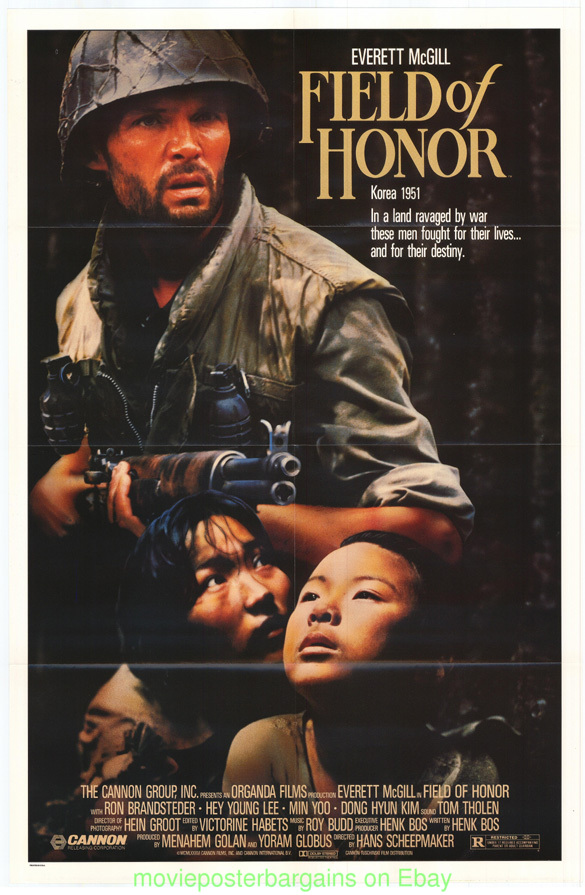
The motion picture "Hell in Korea" aka: "A Hill in Korea" tells the over looked, like the Dutch military, story of British Troops in the United Nations action . It was based upon a popular British novel by Max Catto and was released after the war on September 18, 1956.

The plot sounds standard, as a group of British soldiers might possibly be cut off by advancing Chinese troops. Can they make it out alive? The British unit is made up entirely of "National Service Men".
There was a saying around the United Kingdom, at the time of the U.N. action, about the "National Service Men". National conscription was created in the U.K. after the Second World War and described as:
For my fellow film buffs. Look at the face of the "National Service Man" on the far left of the above photo. That is 16th billed Michael Caine a real "National Service Man" in Korea reliving his war.. From a strictly future stars point of view. "Hell in Korea" starred George Baker, no relation to Stanley Baker and Harry Andrews. However, in the cast besides Caine were Robert Shaw, Stephen Boyd and Percy Herbert.
Between 1951 and 2003 one ally of South Korea would produce and release 47 motion pictures. All set during and around the "United Nations Police Action" and of course this was the United States.
Throughout the 1950's the majority of American War movies were about World War 2. These would reflect the Hollywood/Pentagon/House Committee on Un-American Activities image of the American fighting man. During the first year of Korea, 1950, the audience saw among other World War 2 films an "American Guerrilla in the Philippines" with Tyrone Power and the "Halls of Montezuma" with Richard Widmark. 1950 also saw the military comedy "Francis" about a talking mule with Donald O'Connor. The film would be followed by six sequels. Another comedy "When Willie Comes Marching Home" was directed by John Ford. a
During the second year of Korea, 1951, the movie screen was still dominated by World War 2 pictures. "The Desert Fox: the Story of Rommel" had James Mason in the title role, "The Frogmen" were led by Richard Widmark and based upon a true story was "I Was American Spy" with actress Ann Dvorak in the title role. There were also typical "Gung-Ho" pictures such as John Wayne and Robert Ryan in "The Flying Leathernecks" for American audiences to cheer our guys in a real war they could understand. Korea to American's was an entirely different thing except perhaps, at times, on the motion picture screen with some of those first "Hollywood" releases I will now look at.
The very first Korean War picture fit that "Hollywood Mode" and was released on January 15, 1951. It was entitled "Korea Patrol". The plot was right out of those World War 2 motion pictures. As an American Officer is assigned to a a group of South Korean soldiers instead of Filipino. He leads them on a mission to blow up a bridge to stop the North Korean advance. Substitute Japan for North Korea and we've seen the picture numerous times. Also note the "Tag Line" used on the following poster for the picture,
"Korea Patrol" was followed by a very different War motion picture directed by the unknown Samuel "Sam" Fuller. Fuller had seen service during World War 2 in the "1st Infantry Division" known as "The Big Red One". In 1980 he made a very autobiographical motion picture about the men he knew starring Lee Marvin. The movie featured Mark Hamill as a composite of some of Fuller's fellow "grunts" and Robert Carradine as his alter-ego.
So when you have a director who lived a soldier's life and a actor, Gene Evans, who also lived a soldier's life. Both coming together to make the second American War film set in Korea. You knew they would break the rules of "Hollywood".
Their film was released February 2, 1951 and the title of Samuel Fuller's movie was a metaphor all "grunts" knew "The Steel Helmet"

This 85 minute movie shook up the "Department of the Army" over one scene. Throughout this very stark story of a group of United Nation Soldiers. There is a subplot were Gene Evans' "Sergeant Zack" is being followed by a Korean orphan he nick names "Short Round" played by William Chun. At one point the boy is killed by a North Korean sniper and is mocked by a North Korean Prisoner of War. "Sergeant Zack"s" response is to pull out his pistol and summarily kills the prisoner.
The Pentagon let Executive Producer Robert Lippert know of their displeasure with Samuel Fuller showing such a scene. American soldiers do not shoot POW's without a fair trial. Lippert thanked the Pentagon and left the scene intact. As both combat veterans Fuller and Evans knew. Such scenes happened in real war from both sides.
"The Steel Helmet" also dealt with several issues not normally addressed by any "Hollywood" production. These included an African-American corpsman that a Southern White soldier suggested was a deserter, the problems faced by a conscientious objector, a new Lieutenant with no combat experience and the sometimes fragile relationships between South Korean soldiers and American. All adding to the realism of what Samuel Fuller and Gene Evans had experienced and wanted on the big screen.
Additionally Fuller's soldiers weren't the clean cut images American's were used to seeing with such actors as John Wayne, Richard Widmark, William Holden and the unknown actors in "Korea Patrol" seen above.


On May 5, 1951 RKO Pictures released "Tokyo File: 212". This was an American and Japanese co-production filmed in Japan. The country was still under American occupation at the time. RKO needed permission from General Douglas MacArthur to film there. He approved the picture with actor Lloyd Nolan in the lead. Nolan was not in the movie when it was finally released.
Japanese actor Sessue Hayakawa, the Commander of the POW camp in 1957's "The Bridge On the River Kwai", was to be the main enemy agent. He also was not in the final motion picture cast.
The motion picture ends as General Douglas MacArthur prepares the final elements of "Chromite".
A member of the United Nations coalition was the Netherlands. On September 26, 1986 the Dutch film "Het veld van eer (The Field of Honor)" was released. Filmed in South Korea; the picture begins with a brutal attack by a group of Dutch Troops on a peaceful North Korean village. The men go through the village performing atrocities including rape. After they start to leave Chinese Troops attack them. A Dutch Sergeant "Sire De Jong" is portrayed by American Actor Everett McGill. Who has been seen in David Lynch's "Dune", Television's "Twin Peaks" and "Under Siege 2: Dark Territory" among many other roles. The Dutch Sergeant is hiding in a field from the North Koreans. When he is approached by a young Korean women with her shell shocked little brother. Over time the "Sergeant's" perspective of the war and those involved changes.

The motion picture "Hell in Korea" aka: "A Hill in Korea" tells the over looked, like the Dutch military, story of British Troops in the United Nations action . It was based upon a popular British novel by Max Catto and was released after the war on September 18, 1956.

The plot sounds standard, as a group of British soldiers might possibly be cut off by advancing Chinese troops. Can they make it out alive? The British unit is made up entirely of "National Service Men".
There was a saying around the United Kingdom, at the time of the U.N. action, about the "National Service Men". National conscription was created in the U.K. after the Second World War and described as:
old enough to fight, but too young to vote.That same saying would apply to myself and other young American's during the Vietnam War.
For my fellow film buffs. Look at the face of the "National Service Man" on the far left of the above photo. That is 16th billed Michael Caine a real "National Service Man" in Korea reliving his war.. From a strictly future stars point of view. "Hell in Korea" starred George Baker, no relation to Stanley Baker and Harry Andrews. However, in the cast besides Caine were Robert Shaw, Stephen Boyd and Percy Herbert.
Between 1951 and 2003 one ally of South Korea would produce and release 47 motion pictures. All set during and around the "United Nations Police Action" and of course this was the United States.
Throughout the 1950's the majority of American War movies were about World War 2. These would reflect the Hollywood/Pentagon/House Committee on Un-American Activities image of the American fighting man. During the first year of Korea, 1950, the audience saw among other World War 2 films an "American Guerrilla in the Philippines" with Tyrone Power and the "Halls of Montezuma" with Richard Widmark. 1950 also saw the military comedy "Francis" about a talking mule with Donald O'Connor. The film would be followed by six sequels. Another comedy "When Willie Comes Marching Home" was directed by John Ford. a
During the second year of Korea, 1951, the movie screen was still dominated by World War 2 pictures. "The Desert Fox: the Story of Rommel" had James Mason in the title role, "The Frogmen" were led by Richard Widmark and based upon a true story was "I Was American Spy" with actress Ann Dvorak in the title role. There were also typical "Gung-Ho" pictures such as John Wayne and Robert Ryan in "The Flying Leathernecks" for American audiences to cheer our guys in a real war they could understand. Korea to American's was an entirely different thing except perhaps, at times, on the motion picture screen with some of those first "Hollywood" releases I will now look at.
The very first Korean War picture fit that "Hollywood Mode" and was released on January 15, 1951. It was entitled "Korea Patrol". The plot was right out of those World War 2 motion pictures. As an American Officer is assigned to a a group of South Korean soldiers instead of Filipino. He leads them on a mission to blow up a bridge to stop the North Korean advance. Substitute Japan for North Korea and we've seen the picture numerous times. Also note the "Tag Line" used on the following poster for the picture,
"Korea Patrol" was followed by a very different War motion picture directed by the unknown Samuel "Sam" Fuller. Fuller had seen service during World War 2 in the "1st Infantry Division" known as "The Big Red One". In 1980 he made a very autobiographical motion picture about the men he knew starring Lee Marvin. The movie featured Mark Hamill as a composite of some of Fuller's fellow "grunts" and Robert Carradine as his alter-ego.
So when you have a director who lived a soldier's life and a actor, Gene Evans, who also lived a soldier's life. Both coming together to make the second American War film set in Korea. You knew they would break the rules of "Hollywood".
Their film was released February 2, 1951 and the title of Samuel Fuller's movie was a metaphor all "grunts" knew "The Steel Helmet"

This 85 minute movie shook up the "Department of the Army" over one scene. Throughout this very stark story of a group of United Nation Soldiers. There is a subplot were Gene Evans' "Sergeant Zack" is being followed by a Korean orphan he nick names "Short Round" played by William Chun. At one point the boy is killed by a North Korean sniper and is mocked by a North Korean Prisoner of War. "Sergeant Zack"s" response is to pull out his pistol and summarily kills the prisoner.
The Pentagon let Executive Producer Robert Lippert know of their displeasure with Samuel Fuller showing such a scene. American soldiers do not shoot POW's without a fair trial. Lippert thanked the Pentagon and left the scene intact. As both combat veterans Fuller and Evans knew. Such scenes happened in real war from both sides.
"The Steel Helmet" also dealt with several issues not normally addressed by any "Hollywood" production. These included an African-American corpsman that a Southern White soldier suggested was a deserter, the problems faced by a conscientious objector, a new Lieutenant with no combat experience and the sometimes fragile relationships between South Korean soldiers and American. All adding to the realism of what Samuel Fuller and Gene Evans had experienced and wanted on the big screen.
Additionally Fuller's soldiers weren't the clean cut images American's were used to seeing with such actors as John Wayne, Richard Widmark, William Holden and the unknown actors in "Korea Patrol" seen above.


On May 5, 1951 RKO Pictures released "Tokyo File: 212". This was an American and Japanese co-production filmed in Japan. The country was still under American occupation at the time. RKO needed permission from General Douglas MacArthur to film there. He approved the picture with actor Lloyd Nolan in the lead. Nolan was not in the movie when it was finally released.
Japanese actor Sessue Hayakawa, the Commander of the POW camp in 1957's "The Bridge On the River Kwai", was to be the main enemy agent. He also was not in the final motion picture cast.
The plot was also right out of World War 2 as once again the viewer could substitute the "Japanese" for the "North Koreans", or "Chinese". A Communist spy ring in Japan is attempting to sabotage the American war effort in Korea. An American agent, played by Robert Peyton, is sent to Japan to find the ring and stop it. The girl, Florence Marly, is being blackmailed by the enemy agents by promising to get her sister out of North Korea to freedom. What she doesn't know is her sister is dead.
"Submarine Command" released in November of 1951 is a World War 2 movie that should have stayed in World War 2. Jonathan Latimer's screenplay's has a submarine commanded by William Holden's "Commander Ken White". His wife "Carol" is portrayed by Nancy Olson. William Bendix was the "Chief Petty Officer" and Don Taylor the second in command.
"Submarine Command" released in November of 1951 is a World War 2 movie that should have stayed in World War 2. Jonathan Latimer's screenplay's has a submarine commanded by William Holden's "Commander Ken White". His wife "Carol" is portrayed by Nancy Olson. William Bendix was the "Chief Petty Officer" and Don Taylor the second in command.
The picture starts during World War 2. While on a mission there is an attack upon the boat and William Holden orders a crash dive. That action will save Holden's crew except for a machine gunner left on deck. The whole purpose of these war scenes is to set up the majority of the motion picture on another topic "Stress".
"Commander White" can't escape the memories of leaving one of his crew to die. The screenplay now switches to "Commander White's" attempts to cope with the mental stress the death of the machine gunner is impacting upon his marriage and Naval career. Eventually Holden's "White" can't take it anymore and is set to resign his Navy commission. At exactly this point the North Koreans invade the South. It is this new war that give him a new purpose and is how the film is considered a Korean War picture as two wars book end the "Mental Illness" main portion of the story.
Some reviewers state that "Submarine Command" was the first motion picture to deal with "Post Traumatic Stress Disorder (PTSD)". Even though the term would not be coined until 29 years after its release.
Although there is no question the disorder existed, but not diagnosed as such. The problem with the Jonathan Latimer's story and screenplay is its pace and the fact that within an advertised war film, see the above poster, the mental illness section seems to stop the story. While taking up half of the 87 minute feature and was described as "Brooding" and out of place by film critics. American's were not ready to discuss the effects of war on our fighting men, or acknowledge it was even happening.
"Submarine Command" also was the only American Korean War motion picture about a submarine. Yet during just 1950 through 1959 nine major American motion pictures about submarines in World War 2 were made including two classics. They were 1957's "The Enemy Below" and 1958's "Run Silent, Run Deep". Lest I forget the World War 2 comedy "Operation Petticoat" in 1959 with its pink painted submarine commanded by Cary Grant and Tony Curtis.
On December 6, 1951 Samuel Fuller was back, but working for 20th Century Fox after the unexpected success of "The Steel Helmet". His new feature was "Fixed Bayonets" and Fuller tackled a different aspect of warfare in Korea, but as in his first motion picture characterization was most important.
However, as was to be expected the Department of the Army still objecting to the previous film, Thought they were being clever and assigned U.S. Army Medal of Honor recipient Raymond Harvey as Technical Adviser to control Fuller. The plan backfired as Samuel Fuller was a highly decorated World War 2 veteran, himself, and the two became close friends and worked together on other features besides "Fixed Bayonets".
The story centered around the first winter after the Chinese Communists entered Korea to assist the North. The audience follows the fate of a 48 man platoon left as a rear guard at a choke point as their division withdraws to safety.
Once again Samuel Fuller uses his own experiences and to some extant Lieutenant Colonel Raymond Harvey's to tell his story and create his platoon. At one point the command of the platoon falls to "Corporal Denno" played by Richard Basehart. "Denno" has an aversion to command and has only one concern his own life. He cares nothing about the other platoon members except if they deaths will save his own life.
Among the others in the platoon are Gene Evans as "Sergeant Rock", Skip Homeier is "Whitey", Michael O'Shea as "Sergeant Lonergan" and just for film buffs. Look closely at the film's conclusion and you will see James Dean in his uncredited motion picture debut.

The following title card meant more to Samuel Fuller than one might think and the Department of the Army finally got the message:
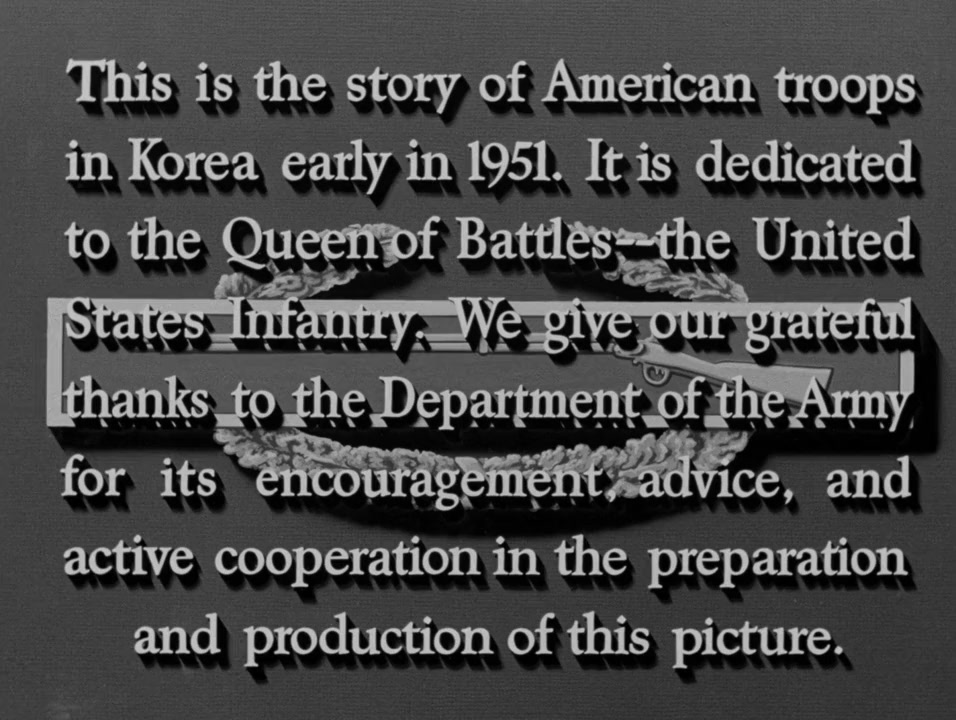
The movie was a subliminal memorial to "The Big Red One". The U.S. 1st Infantry never served in Korea, but in the film characters are named for Fuller's own General Terry de la Mesa Allen, Sr. and his Regimental Commander George A. Taylor. The named regiments in this picture are those of his own World War 2 Division: the 16th, the 18th and the 26th. Also used by the director/writer was General Lesley J. McNair's name.
My article on director Samuel Fuller can be read at:
http://www.bewaretheblog.com/2017/02/samuel-sam-fuller-ever-present-cigar.html
The final Korean War motion picture released in 1951 was from RKO . Once again we have seen this story with different names within motion pictures about the two previous World War's. Released on December 21, 1951 "I Want You" was the story of a typical American family set in Kansas and how Korea impacts them. The film was pure propaganda and had a major 1951 cast. The film was also a plug for the "Selective Service System" aka: "The Draft".
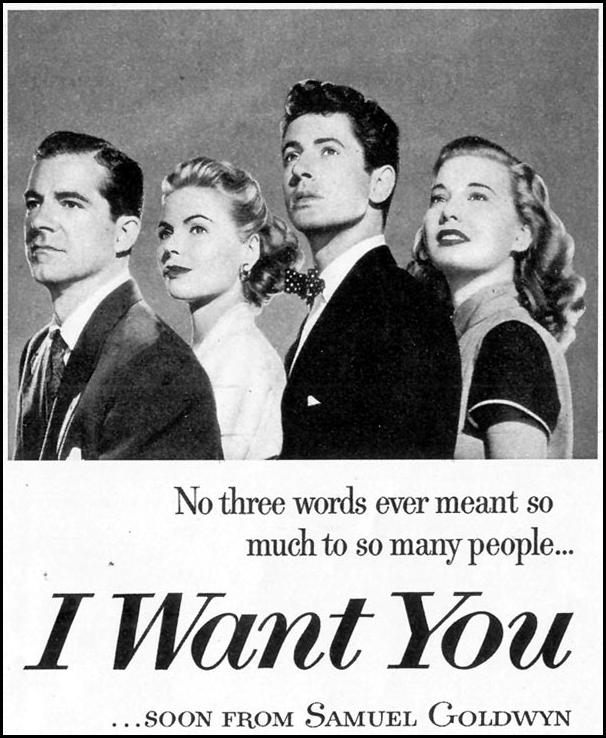
Above Dana Andrews was "Martin Greer", Dorthy McGuire was "Nancy Greer", Farley Granger was "Jack Greer" and Peggy Dow was "Carrie Turner".
These six motion pictures brought American movie goers into the Korean War. I am not going to mention every one of the remaining 41 Hollywood movies revolving around Korea, but will be selective.
Besides mental illness there was another problem of the Korean War that was brought to the forefront for American movie audiences to face . During World War 2, between 1939 and 1945, there had been 177 War movies made by the United States. Only four of these were about Prisoners of War (POW's) and two of the four were about the heroic James Doolittle Raid on Tokyo.While out of the 47 Korean War features SIX dealt with the subject.
The overriding reason there were only four POW movies during the Second World War was a decision made by The Department of Defense and Hollywood. The Government didn't want to affect the morale on the "Home Front". Such stories would have been depressing and if one of those four POW features hadn't been considered important for propaganda reasons. It wouldn't have been released at all. This was the extremely strong 1942 feature "The Purple Heart". A picture about a plane crew shot down after completing the Doolittle Raid. The crew is shown to be HEROIC American's standing up against their Imperial Japanese torturers.
The change in thinking for motion pictures was the result of the "Cold War". Both the Soviet Union and Mainland China were our World War 2 allies. With the official end of the war and the Japanese surrender on the Battleship Missouri a flip occurred. Literally the next morning America was fighting for Democracy against Communist aggression. Suddenly Japan was our ally and COMMUNIST CHINA and the COMMUNIST SOVIET UNION are enemies. Politics in action.
In our Newspapers, over the radio and the new medium of television. American's were being told that even our next door neighbor might be a Communist spy. We had drop and cover drills to protect us from a Soviet Nuclear Attack and Air Raid Drills almost daily. American's read about the "Crusade" against Communism in the United States by Senator Joseph McCarthy and the investigations of the "House Committee on Un-American Activities". Which was even finding Communist Party Members in the Motion Picture Industry. As the "Black Listings" started Richard Carlson played Herbert Philbrick on televisions "I Led 3 Lives". Philbrick had been an average family man, a member of the Communist Party as an infiltrator for the FBI. This was the atmosphere I grew up in.
In mid-1950 American's started reading and hearing about our "Brave Soldiers" being captured by the "Commies" in North Korea, tortured and turning traitor against our American values. Stories of military trials, not ever mentioned during the Second World War, became known to the average American. This was because our Government wanted us informed of the treachery of the Communist nations through sometime called "BRAIN WASHING"! So of course the Motion Picture Industry took up the cause.
On May 4, 1954 the first Korean War movie about American POW's was released from MGM. The title was appropriately "Prisoner of War" and had the full cooperation of the United Army.
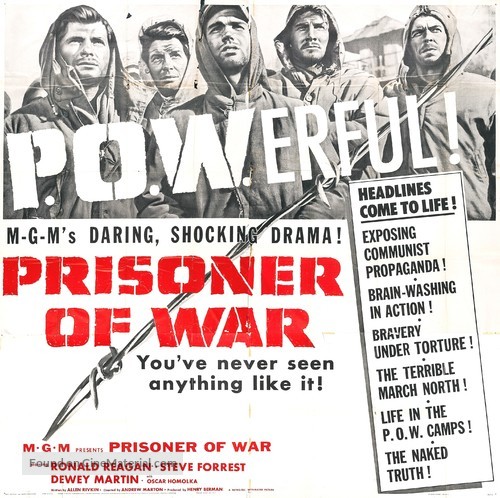
The motion picture starred Ronald Reagan as "Webb Sloane" an Army Officer who volunteers to be captured by the North Koreans. His job is to investigate the reports of torture and brain washing and then, somehow, get that information back to the Army. The film feature co-starred Steve Forrest and Dewey Martin.
Looking at the above poster the first line after "Headlines Come To Life!" is:
Speaking of Actor, not President, Ronald Reagan. For those who might be interested in his motion picture career and not political. My blog article is available at:
http://www.bewaretheblog.com/2016/03/ronald-reagan-motion-picture-and.html
The month prior to the release of "Prisoner of War" American's sat glued to their television screens to watch live coverage of the "Army-McCarthy Hearings". The United States Army was taking Senator Joseph McCarthy to trial in front of the "United States Senate Subcommittee on Investigations" and showing the real power of the still young medium of television..
Columbia Pictures joined MGM in December 1954 with "The Bamboo Prison". The United States Army would not co-operate in the making of this picture. It starred Robert Francis as "Master Sergeant John A, Rand" appearing to be co-operating with the enemy. In actuality "Rand" is an Intelligence Officer attempting to get secret information for the United States. "Corporal Brady", Brian Keith, initially is disgusted with "Rand" until he becomes part of the Intelligence Officer's operation. Almost "Prisoner of War" on a lower budget.

The propaganda tone changed on November 2, 1956 with the release of the Paul Newman vehicle "The Rack". Which was based upon a 1955 story shown on television's "The U.S. Steel Hour" anthology series writen by Rod Sterling. This was the first American made motion picture to actually deal with "Collaboration With The Enemy".

As I mentioned the original Rod Sterling story was seen on television, but now a year later the movie was "Not Suitable For Children".
So what was the story?
Paul Newman's "Captain Edward W. Hall, Jr." has just been released after spending two years in a North Korean Prisoner of War Camp. His father, "Edward W. Hall, Sr.", portrayed by Walter Pidgeon, a retired Colonel, is glad to have his son back as he grieves for the loss of the other one during the war. Newman's sister-in-law, Anne Francis, has problems being around him, because he reminds "Angie" of the loss of her husband. She only confides this concern to a friend, 'Caroline", portrayed by Cloris Leachman.
A friend of the father discovers he is not aware that his son is about to be tried for "Collaboration" and tells him. Senior then confronts Junior son asking why he just didn't die over there? The court-martial begins.
The prosecutor is "Major Sam Moulton", portrayed by Wendell Corey. One of the witnesses called is "Captain John Miller" played by Lee Marvin. "Hall's" defense attorney ":Lieutenant Colonel Frank Vasnick" is portrayed by Edmond O'Brien and he convinces him to take the witness stand to tell his own story.

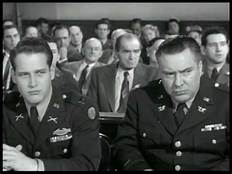
In very stark detail Paul Newman's ""Captain Edward Hall, Jr" starts explaining the torture he underwent. He speaks of being forced to bury soldiers some not even dead. How for four days he carried a wounded man so he wouldn't be put in a grave. How he was in solitary confinement for months at a time and forced to live in his own excrement without knowing if it was day or night. Being told to make a statement and how he turned it into a camouflaged attack on the North by its wording.
Then Newman's "Captain Edward Hall, Jr" reached his breaking point. After being given a letter from his father about the death of his brother.His father has finally attended the trial on the day of his son's testimony. Shocked by the truth he forgives him.
The movie ends with Newman found guilty of treason.
A couple of weeks short of one year later on October 23, 1957 another film on the exact same subject was released. It was based upon a play by the screenwriter Henry Denker and entitled "Time Limit".
Army "Colonel William Edwards", Richard Widmark, has been assigned to investigate the case of "Major Harry Cargill", Richard Basehart, accused of collaborating with the North Koreans and determine if a court-martial is warranted.
"Commander White" can't escape the memories of leaving one of his crew to die. The screenplay now switches to "Commander White's" attempts to cope with the mental stress the death of the machine gunner is impacting upon his marriage and Naval career. Eventually Holden's "White" can't take it anymore and is set to resign his Navy commission. At exactly this point the North Koreans invade the South. It is this new war that give him a new purpose and is how the film is considered a Korean War picture as two wars book end the "Mental Illness" main portion of the story.
Some reviewers state that "Submarine Command" was the first motion picture to deal with "Post Traumatic Stress Disorder (PTSD)". Even though the term would not be coined until 29 years after its release.
Although there is no question the disorder existed, but not diagnosed as such. The problem with the Jonathan Latimer's story and screenplay is its pace and the fact that within an advertised war film, see the above poster, the mental illness section seems to stop the story. While taking up half of the 87 minute feature and was described as "Brooding" and out of place by film critics. American's were not ready to discuss the effects of war on our fighting men, or acknowledge it was even happening.
"Submarine Command" also was the only American Korean War motion picture about a submarine. Yet during just 1950 through 1959 nine major American motion pictures about submarines in World War 2 were made including two classics. They were 1957's "The Enemy Below" and 1958's "Run Silent, Run Deep". Lest I forget the World War 2 comedy "Operation Petticoat" in 1959 with its pink painted submarine commanded by Cary Grant and Tony Curtis.
On December 6, 1951 Samuel Fuller was back, but working for 20th Century Fox after the unexpected success of "The Steel Helmet". His new feature was "Fixed Bayonets" and Fuller tackled a different aspect of warfare in Korea, but as in his first motion picture characterization was most important.
However, as was to be expected the Department of the Army still objecting to the previous film, Thought they were being clever and assigned U.S. Army Medal of Honor recipient Raymond Harvey as Technical Adviser to control Fuller. The plan backfired as Samuel Fuller was a highly decorated World War 2 veteran, himself, and the two became close friends and worked together on other features besides "Fixed Bayonets".
The story centered around the first winter after the Chinese Communists entered Korea to assist the North. The audience follows the fate of a 48 man platoon left as a rear guard at a choke point as their division withdraws to safety.
Once again Samuel Fuller uses his own experiences and to some extant Lieutenant Colonel Raymond Harvey's to tell his story and create his platoon. At one point the command of the platoon falls to "Corporal Denno" played by Richard Basehart. "Denno" has an aversion to command and has only one concern his own life. He cares nothing about the other platoon members except if they deaths will save his own life.
Among the others in the platoon are Gene Evans as "Sergeant Rock", Skip Homeier is "Whitey", Michael O'Shea as "Sergeant Lonergan" and just for film buffs. Look closely at the film's conclusion and you will see James Dean in his uncredited motion picture debut.

The following title card meant more to Samuel Fuller than one might think and the Department of the Army finally got the message:

The movie was a subliminal memorial to "The Big Red One". The U.S. 1st Infantry never served in Korea, but in the film characters are named for Fuller's own General Terry de la Mesa Allen, Sr. and his Regimental Commander George A. Taylor. The named regiments in this picture are those of his own World War 2 Division: the 16th, the 18th and the 26th. Also used by the director/writer was General Lesley J. McNair's name.
My article on director Samuel Fuller can be read at:
http://www.bewaretheblog.com/2017/02/samuel-sam-fuller-ever-present-cigar.html
The final Korean War motion picture released in 1951 was from RKO . Once again we have seen this story with different names within motion pictures about the two previous World War's. Released on December 21, 1951 "I Want You" was the story of a typical American family set in Kansas and how Korea impacts them. The film was pure propaganda and had a major 1951 cast. The film was also a plug for the "Selective Service System" aka: "The Draft".

Above Dana Andrews was "Martin Greer", Dorthy McGuire was "Nancy Greer", Farley Granger was "Jack Greer" and Peggy Dow was "Carrie Turner".
These six motion pictures brought American movie goers into the Korean War. I am not going to mention every one of the remaining 41 Hollywood movies revolving around Korea, but will be selective.
Besides mental illness there was another problem of the Korean War that was brought to the forefront for American movie audiences to face . During World War 2, between 1939 and 1945, there had been 177 War movies made by the United States. Only four of these were about Prisoners of War (POW's) and two of the four were about the heroic James Doolittle Raid on Tokyo.While out of the 47 Korean War features SIX dealt with the subject.
The overriding reason there were only four POW movies during the Second World War was a decision made by The Department of Defense and Hollywood. The Government didn't want to affect the morale on the "Home Front". Such stories would have been depressing and if one of those four POW features hadn't been considered important for propaganda reasons. It wouldn't have been released at all. This was the extremely strong 1942 feature "The Purple Heart". A picture about a plane crew shot down after completing the Doolittle Raid. The crew is shown to be HEROIC American's standing up against their Imperial Japanese torturers.
The change in thinking for motion pictures was the result of the "Cold War". Both the Soviet Union and Mainland China were our World War 2 allies. With the official end of the war and the Japanese surrender on the Battleship Missouri a flip occurred. Literally the next morning America was fighting for Democracy against Communist aggression. Suddenly Japan was our ally and COMMUNIST CHINA and the COMMUNIST SOVIET UNION are enemies. Politics in action.
In our Newspapers, over the radio and the new medium of television. American's were being told that even our next door neighbor might be a Communist spy. We had drop and cover drills to protect us from a Soviet Nuclear Attack and Air Raid Drills almost daily. American's read about the "Crusade" against Communism in the United States by Senator Joseph McCarthy and the investigations of the "House Committee on Un-American Activities". Which was even finding Communist Party Members in the Motion Picture Industry. As the "Black Listings" started Richard Carlson played Herbert Philbrick on televisions "I Led 3 Lives". Philbrick had been an average family man, a member of the Communist Party as an infiltrator for the FBI. This was the atmosphere I grew up in.
In mid-1950 American's started reading and hearing about our "Brave Soldiers" being captured by the "Commies" in North Korea, tortured and turning traitor against our American values. Stories of military trials, not ever mentioned during the Second World War, became known to the average American. This was because our Government wanted us informed of the treachery of the Communist nations through sometime called "BRAIN WASHING"! So of course the Motion Picture Industry took up the cause.
On May 4, 1954 the first Korean War movie about American POW's was released from MGM. The title was appropriately "Prisoner of War" and had the full cooperation of the United Army.

The motion picture starred Ronald Reagan as "Webb Sloane" an Army Officer who volunteers to be captured by the North Koreans. His job is to investigate the reports of torture and brain washing and then, somehow, get that information back to the Army. The film feature co-starred Steve Forrest and Dewey Martin.
Looking at the above poster the first line after "Headlines Come To Life!" is:
EXPOSING COMMUNIST PROPAGANDA!Not to mention that this film, approved by the Department of Defense, was our own propaganda.
Speaking of Actor, not President, Ronald Reagan. For those who might be interested in his motion picture career and not political. My blog article is available at:
http://www.bewaretheblog.com/2016/03/ronald-reagan-motion-picture-and.html
The month prior to the release of "Prisoner of War" American's sat glued to their television screens to watch live coverage of the "Army-McCarthy Hearings". The United States Army was taking Senator Joseph McCarthy to trial in front of the "United States Senate Subcommittee on Investigations" and showing the real power of the still young medium of television..
Columbia Pictures joined MGM in December 1954 with "The Bamboo Prison". The United States Army would not co-operate in the making of this picture. It starred Robert Francis as "Master Sergeant John A, Rand" appearing to be co-operating with the enemy. In actuality "Rand" is an Intelligence Officer attempting to get secret information for the United States. "Corporal Brady", Brian Keith, initially is disgusted with "Rand" until he becomes part of the Intelligence Officer's operation. Almost "Prisoner of War" on a lower budget.

The propaganda tone changed on November 2, 1956 with the release of the Paul Newman vehicle "The Rack". Which was based upon a 1955 story shown on television's "The U.S. Steel Hour" anthology series writen by Rod Sterling. This was the first American made motion picture to actually deal with "Collaboration With The Enemy".

As I mentioned the original Rod Sterling story was seen on television, but now a year later the movie was "Not Suitable For Children".
So what was the story?
Paul Newman's "Captain Edward W. Hall, Jr." has just been released after spending two years in a North Korean Prisoner of War Camp. His father, "Edward W. Hall, Sr.", portrayed by Walter Pidgeon, a retired Colonel, is glad to have his son back as he grieves for the loss of the other one during the war. Newman's sister-in-law, Anne Francis, has problems being around him, because he reminds "Angie" of the loss of her husband. She only confides this concern to a friend, 'Caroline", portrayed by Cloris Leachman.
A friend of the father discovers he is not aware that his son is about to be tried for "Collaboration" and tells him. Senior then confronts Junior son asking why he just didn't die over there? The court-martial begins.
The prosecutor is "Major Sam Moulton", portrayed by Wendell Corey. One of the witnesses called is "Captain John Miller" played by Lee Marvin. "Hall's" defense attorney ":Lieutenant Colonel Frank Vasnick" is portrayed by Edmond O'Brien and he convinces him to take the witness stand to tell his own story.
In very stark detail Paul Newman's ""Captain Edward Hall, Jr" starts explaining the torture he underwent. He speaks of being forced to bury soldiers some not even dead. How for four days he carried a wounded man so he wouldn't be put in a grave. How he was in solitary confinement for months at a time and forced to live in his own excrement without knowing if it was day or night. Being told to make a statement and how he turned it into a camouflaged attack on the North by its wording.
Then Newman's "Captain Edward Hall, Jr" reached his breaking point. After being given a letter from his father about the death of his brother.His father has finally attended the trial on the day of his son's testimony. Shocked by the truth he forgives him.
The movie ends with Newman found guilty of treason.
A couple of weeks short of one year later on October 23, 1957 another film on the exact same subject was released. It was based upon a play by the screenwriter Henry Denker and entitled "Time Limit".
Army "Colonel William Edwards", Richard Widmark, has been assigned to investigate the case of "Major Harry Cargill", Richard Basehart, accused of collaborating with the North Koreans and determine if a court-martial is warranted.
The court-martial seems an open and shut case, but for some reason "Major Cargill" won't say a word in his defense. As he investigates "Colonel Edwards" learns that two of "Cargill's" soldiers were killed immediately prior to the start of his collaboration. Additionally, what seems weird is that the surviving soldiers in "Major Cargill's" unit use the exact same words to describe what happened. A sign of "Brain Washing" that will become more critical in the next movie I mention.
"General Connors", Carl Benton Reid, has a special interest in seeing that "Major Cargill" receives a court-martial. His son "Captain Joe Connors", Yale Wexler, was one of the two men killed attempting to escape after "Cargill" informed the North Korean. The plot takes a twist when the truth comes out.
The General's son wasn't killed escaping. He was the traitor and the other men in the unit drew straws to see who would kill him. "Cargill" tried to stop them, but was kept away as the "Execution" was carried out by his unit.
Hearing this and getting verification the General now calls his own son a traitor. "Major Cargill" argues to "General Connors" that there must be a "Time Limit" on being a hero. The Major denounces the military "Uniform Code of Military Justice" the General quotes to justify what the unit did to his son.
It is now discovered that "Major Harry Cargill" was given an ultimatum by North Korean "Colonel Kim", Khigh Dhiegh, to collaborate or the rest of the unit would be executed. He chooses to save his men. The decision is made to court-martial "Major Cargill" and "Colonel Edwards" says he will defend him.
Richard Condon worked a terrifying scenario in his 1959 novel "The Manchurian Candidate" and on October 24, 1962 Co-Producer and Director John Frankenheimer brought it to movie audiences in an equally terrifying motion picture. American's darkest fears of a Communist take over was tied to "The Yellow Peril" and the Korean War of Co-Producer and Screenplay writer George Axelrod,
He used Condon's story and characters to create the tight guessing game political thriller. Together Condon, Frankenheimer and Axelrod created a political term that is still being used today, by some, in relation to the current President of the United States, right or wrong.
The General's son wasn't killed escaping. He was the traitor and the other men in the unit drew straws to see who would kill him. "Cargill" tried to stop them, but was kept away as the "Execution" was carried out by his unit.
Hearing this and getting verification the General now calls his own son a traitor. "Major Cargill" argues to "General Connors" that there must be a "Time Limit" on being a hero. The Major denounces the military "Uniform Code of Military Justice" the General quotes to justify what the unit did to his son.
It is now discovered that "Major Harry Cargill" was given an ultimatum by North Korean "Colonel Kim", Khigh Dhiegh, to collaborate or the rest of the unit would be executed. He chooses to save his men. The decision is made to court-martial "Major Cargill" and "Colonel Edwards" says he will defend him.
Richard Condon worked a terrifying scenario in his 1959 novel "The Manchurian Candidate" and on October 24, 1962 Co-Producer and Director John Frankenheimer brought it to movie audiences in an equally terrifying motion picture. American's darkest fears of a Communist take over was tied to "The Yellow Peril" and the Korean War of Co-Producer and Screenplay writer George Axelrod,
He used Condon's story and characters to create the tight guessing game political thriller. Together Condon, Frankenheimer and Axelrod created a political term that is still being used today, by some, in relation to the current President of the United States, right or wrong.
The first tag line on the above poster greeted myself and other viewers when the motion picture first came out:
The opening credits begin to roll.
The story takes place after Korea and concentrates upon two specific soldiers. One is "Major Bennett Marco" perfectly played by Frank Sinatra. He was a Captain at the time of his platoon's capture. "Marco" has been experiencing vivid nightmares and is being treated by the Veterans Administration for them.

The other soldier is "Staff Sergeant Raymond Shaw" portrayed by Lawrence Harvey". "Shaw" has returned to a loving mother and step father. For his service and valor, as testified by the platoon's survivors, "Raymond Shaw" was awarded the "Congressional Medal of Honor" for heroism.

Portraying "Raymond's" mother was Angela Lansbury. She is now remarried to "Senator Iselin"
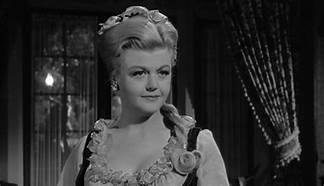
James Gregory portrays "Senator John Yerkes Iselin". A possible candidate for the Vice Presidency of the United States. The character is modeled after Senator Joseph McCarthy.
.
These four are the characters the story revolves around. The feature co-stars Janet Lee as Sinatra's love interest "Eugenie Rose Chaney".

Henry Silva plays "Chunjin". The audience knows, from the opening five minutes, that he was the guide for the American soldiers who were captured and now is the "Houseboy" for Lansbury, Gregory, and Harvey. In reality he is a North Korean Army Officer.
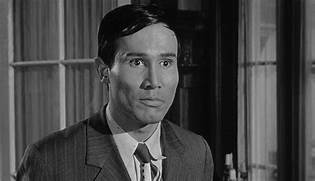
Khigh Dheigh plays the Communist Chinese "Dr. Yen Lo".

Before I go further into the plot. I would point out what had started eight days prior to this picture's release. On the exact date of my 16th Birthday, October 16, 1962. The United States and the Soviet Union were on the brink of Nuclear War from what became known as "The Cuban Missile Crisis".
Tensions were very high and into that unstable climate came John Frankenheimer's "The Manchurian Candidate". Adding to America's Cold War fears I have previously mentioned.
"Major Marco's" has been having dreams, nightmares more likely, and he seems to be attempting to remember something, but what?
One thing that "Marco" is noticing is that he has a strong friendship with "Raymond Shaw", but this seems false in some way. Ask "Marco" what he thinks of "Raymond" and immediately, every time, he repeats:
Some of the Major's nightmares show the platoon on a stage with a Chinese Doctor explaining a theory to his audience.
You must not miss the five minutes to know what it's all about!Those words were extremely important to the plot. The first five minutes of the picture are prior to the opening credits and places the audience in Korea during the war. They witness a U.S. Army platoon captured by North Koreans. This is the set up for what follows as the audience does not know what happened to those soldiers.
The opening credits begin to roll.
The story takes place after Korea and concentrates upon two specific soldiers. One is "Major Bennett Marco" perfectly played by Frank Sinatra. He was a Captain at the time of his platoon's capture. "Marco" has been experiencing vivid nightmares and is being treated by the Veterans Administration for them.
The other soldier is "Staff Sergeant Raymond Shaw" portrayed by Lawrence Harvey". "Shaw" has returned to a loving mother and step father. For his service and valor, as testified by the platoon's survivors, "Raymond Shaw" was awarded the "Congressional Medal of Honor" for heroism.

Portraying "Raymond's" mother was Angela Lansbury. She is now remarried to "Senator Iselin"
James Gregory portrays "Senator John Yerkes Iselin". A possible candidate for the Vice Presidency of the United States. The character is modeled after Senator Joseph McCarthy.
.
These four are the characters the story revolves around. The feature co-stars Janet Lee as Sinatra's love interest "Eugenie Rose Chaney".

Henry Silva plays "Chunjin". The audience knows, from the opening five minutes, that he was the guide for the American soldiers who were captured and now is the "Houseboy" for Lansbury, Gregory, and Harvey. In reality he is a North Korean Army Officer.
Khigh Dheigh plays the Communist Chinese "Dr. Yen Lo".
Before I go further into the plot. I would point out what had started eight days prior to this picture's release. On the exact date of my 16th Birthday, October 16, 1962. The United States and the Soviet Union were on the brink of Nuclear War from what became known as "The Cuban Missile Crisis".
Tensions were very high and into that unstable climate came John Frankenheimer's "The Manchurian Candidate". Adding to America's Cold War fears I have previously mentioned.
"Major Marco's" has been having dreams, nightmares more likely, and he seems to be attempting to remember something, but what?
One thing that "Marco" is noticing is that he has a strong friendship with "Raymond Shaw", but this seems false in some way. Ask "Marco" what he thinks of "Raymond" and immediately, every time, he repeats:
Raymond Shaw is the kindest, bravest, warmest, most wonderful human being I've ever known in my life."Marco" begins to speak to members of his platoon. He discovers that every other member when asked what they think of Shaw. Repeats, word for word, the exact same answer he does.
Some of the Major's nightmares show the platoon on a stage with a Chinese Doctor explaining a theory to his audience.
Then the "Doctor" asks "Raymond" to take a pistol and shoot one of the other members of his captured platoon. "Shaw" complies as the other soldiers and his intended victim just ignore everything he is doing as if this is normal. Two killings will happen in "Major Marco's" nightmarish dreams. The two he dreamed of "Raymond Shaw" shooting turn out to be the two missing in action men from his platoon after the war has ended.
Sometimes the nightmare's setting changes, but the actions remain the same.
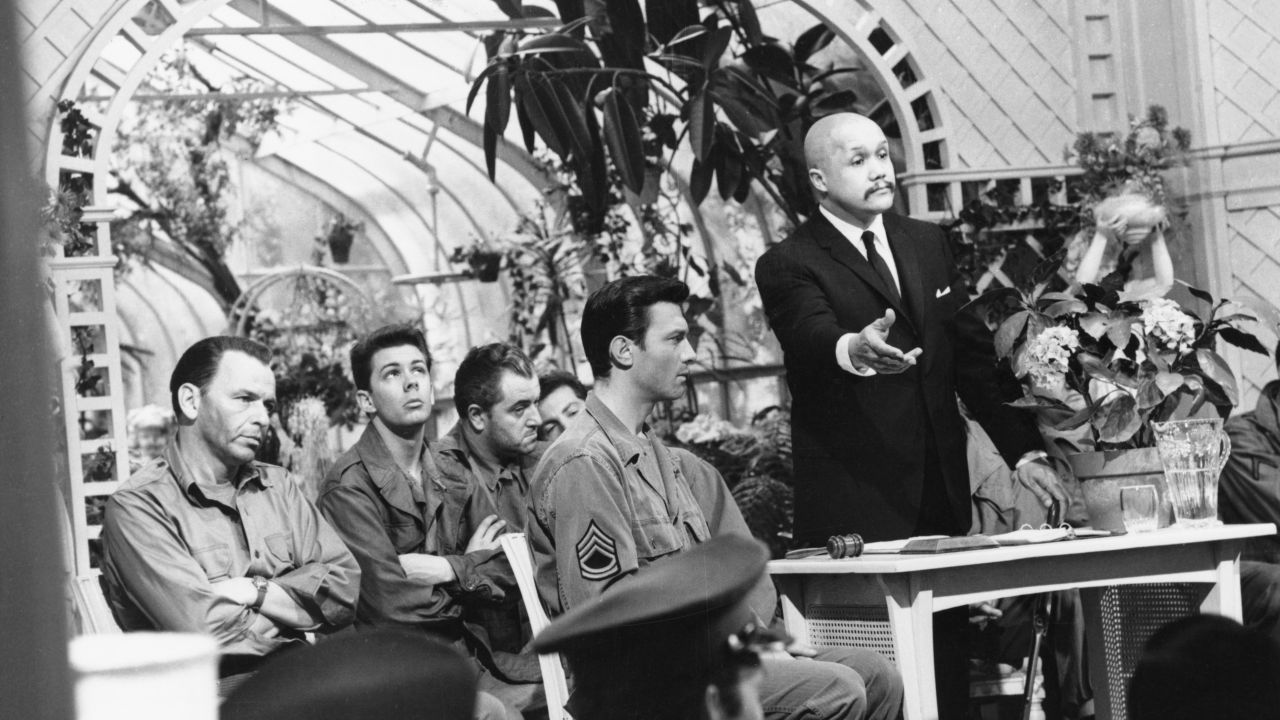
In one dream the Chinese Doctor starts out as women addressing a gathering of other women interested in horticulture.

In another nightmare all the participants in the audience become African-American women as does the Chinese Doctor addressing them.

"Major Marco" decides to go to Army Intelligence with his concerns. Which seem to point to his platoon having been "Brain Washed", but for what objective? Also he questions why his platoon suddenly likes "Raymond Shaw"? Whom "Marco" now remembers was extremely disliked?

Things start to fall into place. When "Raymond's" Step-father, "Senator Iselin", is driven by his wife to start claiming that the Department of Defense is full of Communist agents. Her domineering personality gets her husband to campaign for the Vice President spot on his unnamed political party's ticket.
The audience learns that "Raymond Shaw" has been "Brain Washed" by the Chinese Communist. He must obey any command given to him after seeing the playing card the "Queen of Diamonds". Other than the houseboy "Chunjin" is there someone else?
At a costume party, given by his mother, to obtain support for his Step-father's run for the Vice Presidential nomination. "Raymond Shaw's" old girlfriend "Jocelyn Jordon", Leslie Parrish, shows up wearing a "Queen of Diamonds" costume. This accidental costume sets off "Raymond" in an unexpected way. "Jocelyn" reminds him of his wartime promises of marriage. Under the influence of the costume the two elope. One problem for the two is that "Jocelyn Jordon's" father is "Senator Thomas Jordon" a political foe of "Iselin's".
This unforeseen elopement will lead to revealing that "Raymond's" mother is a Communist agent and his controller. To help her husband she has her son murder "Senator Jordon" in his home. "Jocelyn" walks in and is murdered also..Afterwards, "Raymond" has no knowledge of what he did and is grief stricken over the murders by persons unknown..
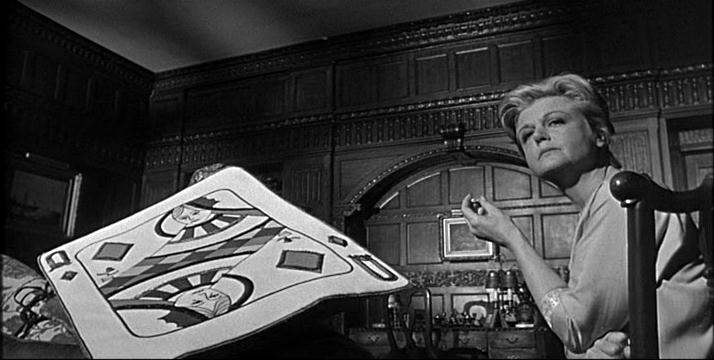
Meanwhile, "Major Marco" goes to "Shaw's" apartment and recognizes the Houseboy as "Chunjin". While attempting to find out what the North Korean is doing there. A fight starts between the two men, but the.other house staff stop the fight and "Marco" leaves with more questions than answers.
Army Intelligence has figured out the probability of the "Queen of Hearts" triggering "Raymond Shaw". They believe that whomever is controlling him is planning to get "Iselin" the Vice Presidential nomination. Adding that probably the Presidential candidate will be assassinated by "Shaw". Which would make "Senator John Yerkes Iselin" a Presidential candidate with the sympathy of the American people. The unknowing "Senator Iselin" would become the Chinese Communist's "MANCHURIAN CANDIDATE". Being controlled by some unknown person, but someone who has to have easy access to "Raymond Shaw"..
"Marco" goes to "Shaw" with a deck of cards with nothing but "Queen of Diamonds" in an attempt to clear his "Brain Washing".
The climax comes at the unnamed Party's convention in Madison Square Garden in New York City. The clear headed, maybe, "Raymond Shaw" takes the sniper rifle his mother had left for him and goes into a room with a view of the stage. "Marco" attempts to stop him, but is himself stopped by "Raymond".

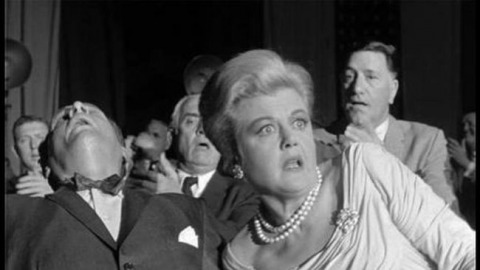
In the now locked room "Raymond" views the stage and sees his mother and step-father/ The first shot takes out "Senator Iselin" and the second his mother. "Major Marco" breaks in just as "Raymond Shaw" wearing his Congressional Medal of Honor kills himself.
As I said the timing of the release of "The Manchurian Candidate" couldn't have been more perfect, if it had been planned. The subject matter had always been in the recesses of most American adults minds since the start of the "Cold War". President Kennedy had been escalating the involvement of the United States, slowly, in a country most American's didn't know existed called Vietnam and of course there were those events, I mentioned, that started on my birthday. America's nightmare had reached the screen in a tightly made politically thriller. Could it ever actually happen?

The sixth motion picture about an American soldier accused of being a traitor during the Korean War was "Sergeant Ryker". The title character was portrayed by Lee Marvin and it was released February 1, 1968. The interesting counterpoint to this motion picture is that it wasn't a motion picture at all, but a two part "Kraft Suspense Theater" television production entitled "The Case Against Paul Ryker". Which originally aired five years earlier on October 10, 1963 and October 17, 1963. The television episodes were edited together into the feature film, because of the popularity of Lee Marvin from the June 15, 1967 motion picture "The Dirty Dozen".
Sometimes the nightmare's setting changes, but the actions remain the same.

In one dream the Chinese Doctor starts out as women addressing a gathering of other women interested in horticulture.

In another nightmare all the participants in the audience become African-American women as does the Chinese Doctor addressing them.

"Major Marco" decides to go to Army Intelligence with his concerns. Which seem to point to his platoon having been "Brain Washed", but for what objective? Also he questions why his platoon suddenly likes "Raymond Shaw"? Whom "Marco" now remembers was extremely disliked?

Things start to fall into place. When "Raymond's" Step-father, "Senator Iselin", is driven by his wife to start claiming that the Department of Defense is full of Communist agents. Her domineering personality gets her husband to campaign for the Vice President spot on his unnamed political party's ticket.
The audience learns that "Raymond Shaw" has been "Brain Washed" by the Chinese Communist. He must obey any command given to him after seeing the playing card the "Queen of Diamonds". Other than the houseboy "Chunjin" is there someone else?
At a costume party, given by his mother, to obtain support for his Step-father's run for the Vice Presidential nomination. "Raymond Shaw's" old girlfriend "Jocelyn Jordon", Leslie Parrish, shows up wearing a "Queen of Diamonds" costume. This accidental costume sets off "Raymond" in an unexpected way. "Jocelyn" reminds him of his wartime promises of marriage. Under the influence of the costume the two elope. One problem for the two is that "Jocelyn Jordon's" father is "Senator Thomas Jordon" a political foe of "Iselin's".
This unforeseen elopement will lead to revealing that "Raymond's" mother is a Communist agent and his controller. To help her husband she has her son murder "Senator Jordon" in his home. "Jocelyn" walks in and is murdered also..Afterwards, "Raymond" has no knowledge of what he did and is grief stricken over the murders by persons unknown..

Meanwhile, "Major Marco" goes to "Shaw's" apartment and recognizes the Houseboy as "Chunjin". While attempting to find out what the North Korean is doing there. A fight starts between the two men, but the.other house staff stop the fight and "Marco" leaves with more questions than answers.
Army Intelligence has figured out the probability of the "Queen of Hearts" triggering "Raymond Shaw". They believe that whomever is controlling him is planning to get "Iselin" the Vice Presidential nomination. Adding that probably the Presidential candidate will be assassinated by "Shaw". Which would make "Senator John Yerkes Iselin" a Presidential candidate with the sympathy of the American people. The unknowing "Senator Iselin" would become the Chinese Communist's "MANCHURIAN CANDIDATE". Being controlled by some unknown person, but someone who has to have easy access to "Raymond Shaw"..
"Marco" goes to "Shaw" with a deck of cards with nothing but "Queen of Diamonds" in an attempt to clear his "Brain Washing".
The climax comes at the unnamed Party's convention in Madison Square Garden in New York City. The clear headed, maybe, "Raymond Shaw" takes the sniper rifle his mother had left for him and goes into a room with a view of the stage. "Marco" attempts to stop him, but is himself stopped by "Raymond".


In the now locked room "Raymond" views the stage and sees his mother and step-father/ The first shot takes out "Senator Iselin" and the second his mother. "Major Marco" breaks in just as "Raymond Shaw" wearing his Congressional Medal of Honor kills himself.
As I said the timing of the release of "The Manchurian Candidate" couldn't have been more perfect, if it had been planned. The subject matter had always been in the recesses of most American adults minds since the start of the "Cold War". President Kennedy had been escalating the involvement of the United States, slowly, in a country most American's didn't know existed called Vietnam and of course there were those events, I mentioned, that started on my birthday. America's nightmare had reached the screen in a tightly made politically thriller. Could it ever actually happen?

The sixth motion picture about an American soldier accused of being a traitor during the Korean War was "Sergeant Ryker". The title character was portrayed by Lee Marvin and it was released February 1, 1968. The interesting counterpoint to this motion picture is that it wasn't a motion picture at all, but a two part "Kraft Suspense Theater" television production entitled "The Case Against Paul Ryker". Which originally aired five years earlier on October 10, 1963 and October 17, 1963. The television episodes were edited together into the feature film, because of the popularity of Lee Marvin from the June 15, 1967 motion picture "The Dirty Dozen".
The teleplay, or screenplay, take your pick. Tells of "Sergeant Paul Ryker", Lee Marvin, appearing at his court-martial for treason during the Korean War. The prosecutor is "Captain David Young", Bradford Dillman, who wins a conviction with a sentence of death.
"Ryker's" wife "Ann", Vera Miles, believes two things about her husband. The first was the Army provided him with an inadequate defense. The second that he was on a secret mission, but the officer who assigned it to him has since died. "Ann" is able to convince "Captain Young" that her husband deserves a new trial. "Young" is able to convince "General Amos Bailey", Lloyd Nolan, to authorize a new trial. "Young" volunteers to defend "Paul Ryker" and the prosecutor is now the defense lawyer.
The new prosecutor is "Major Whitaker", Peter Graves, who finds even more incriminating evidence against "Sergeant Ryker", but "Captain Young" is able to find another Sergeant named "Winker" played by Norman Fell. "Winker" is able to verify most of "Ryker's" story.

I want to finish this article with just a few more examples starting with a war time love story set in a unit overlooked during all 177 World War 2 films..
"Battle Circus" starred Humphrey Bogart and June Allyson.
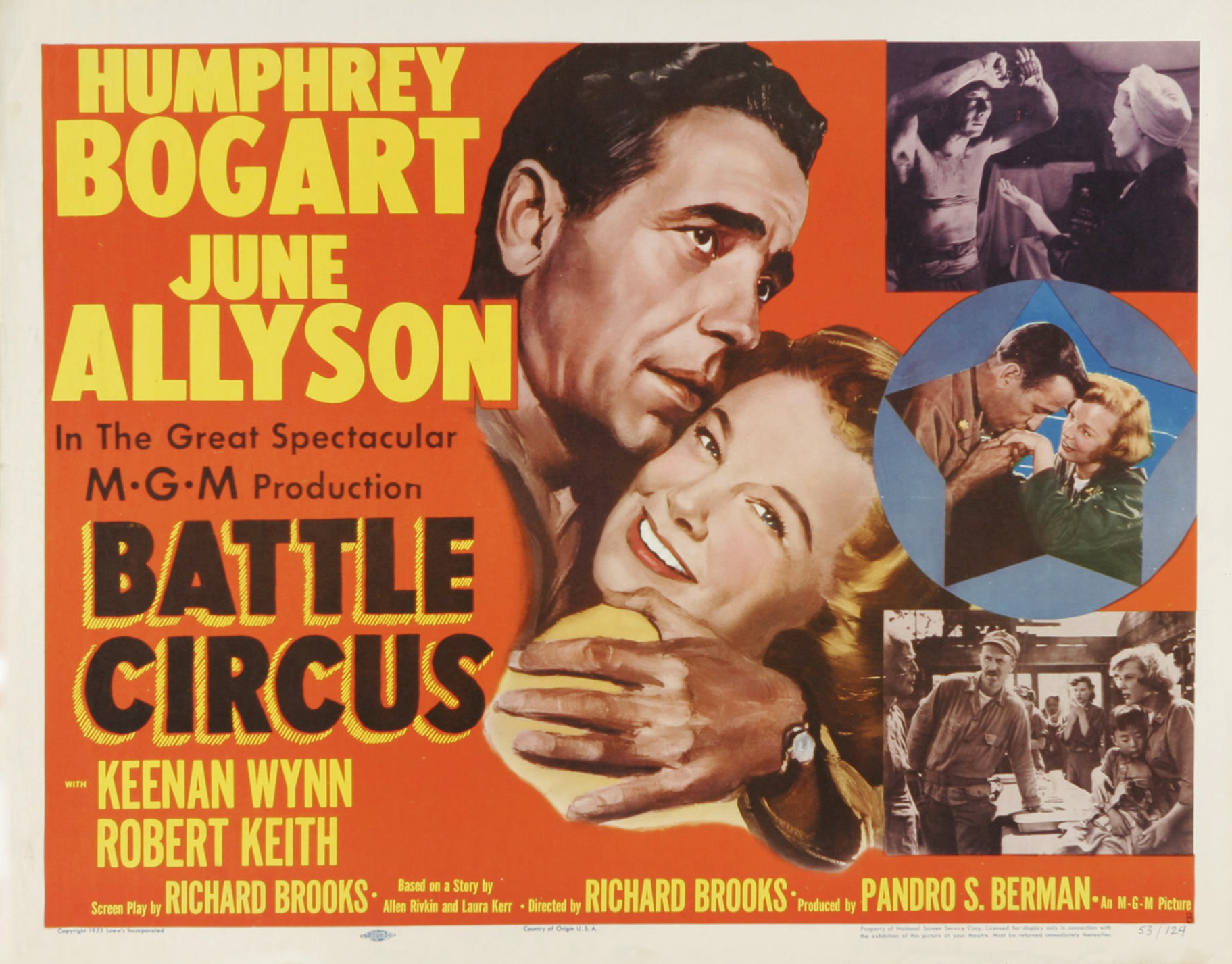
This was "Bogie's" second motion picture since the "African Queen" set during the First World War and two films before "The Caine Mutinty" set during the Second World War.. June Allyson was two films away from her second of three opposite Jimmy Stewart "The Glenn Miller Story". Pure Hollywood bio fiction as had been her first with him "The Stratton Story" in 1949. The third would be "Strategic Air Command" co-starring Air Force General Jimmy Stewart.
"Battle Circus" had been written and directed by Richard Brooks. Brooks would become best known for directing 1955's "Blackboard Jungle", 1958's "Cat on a Hot Tin Roof" and 1960's "Elmer Gentry". He would win two Oscars for writing the screen play in 1967 for Truman Capote's "In Cold Blood" and the screenplay for 1977's "Looking for Mr. Goodbar". As I just mention back on March 6, 1953 Brooks had looked at an untouched subject during World War 2. The "Mobile Army's Surgical Hospital (MASH)" for the first time.
The title of the picture came from the name the "MASH" units were referred too. It was derived from the fact that they used large Circus size tents that had to be taken down and moved at a moments notice and of the battles in their area.
Bogart was Army Surgeon "Major Jed Webbe" and Allyson was the newly arrived nurse "Lieutenant Ruth McGara" soon to be his love interest. However, according to a 1988 interview given by Brooks. The picture was originally titled "MASH 66", but MGM thought the potential audience would have no idea what a "MASH" Unit was as they'd never been seen in a war film before.

Richard Brooks' screenplay besides the required love story had three interesting plot points. The first has a Korean child needing open heart surgery. the second has a helicopter pilot having to fly needed blood supplies to the unit during a fierce ice storm and the third deals with the treatment of North Korean POW's. One very frightened man has a hand grenade and Allyson's nurse has to calm the man and get it away so the unit may treat him. All three were actual events Richard Brooks had researched. Along with showing the unit having to strike their camp as surgery is being performed and escape advancing North Korean Troops.
_01.jpg)
_13.jpg)
Switch from Richard Brooks' look at a Mobile Army Surgical Hospital to director Robert Altman's irrelevant black comedy released January 25, 1970 from a great screenplay by Ring Lardner, Jr. "M*A*S*H".
"Ryker's" wife "Ann", Vera Miles, believes two things about her husband. The first was the Army provided him with an inadequate defense. The second that he was on a secret mission, but the officer who assigned it to him has since died. "Ann" is able to convince "Captain Young" that her husband deserves a new trial. "Young" is able to convince "General Amos Bailey", Lloyd Nolan, to authorize a new trial. "Young" volunteers to defend "Paul Ryker" and the prosecutor is now the defense lawyer.
The new prosecutor is "Major Whitaker", Peter Graves, who finds even more incriminating evidence against "Sergeant Ryker", but "Captain Young" is able to find another Sergeant named "Winker" played by Norman Fell. "Winker" is able to verify most of "Ryker's" story.

I want to finish this article with just a few more examples starting with a war time love story set in a unit overlooked during all 177 World War 2 films..
"Battle Circus" starred Humphrey Bogart and June Allyson.

This was "Bogie's" second motion picture since the "African Queen" set during the First World War and two films before "The Caine Mutinty" set during the Second World War.. June Allyson was two films away from her second of three opposite Jimmy Stewart "The Glenn Miller Story". Pure Hollywood bio fiction as had been her first with him "The Stratton Story" in 1949. The third would be "Strategic Air Command" co-starring Air Force General Jimmy Stewart.
"Battle Circus" had been written and directed by Richard Brooks. Brooks would become best known for directing 1955's "Blackboard Jungle", 1958's "Cat on a Hot Tin Roof" and 1960's "Elmer Gentry". He would win two Oscars for writing the screen play in 1967 for Truman Capote's "In Cold Blood" and the screenplay for 1977's "Looking for Mr. Goodbar". As I just mention back on March 6, 1953 Brooks had looked at an untouched subject during World War 2. The "Mobile Army's Surgical Hospital (MASH)" for the first time.
The title of the picture came from the name the "MASH" units were referred too. It was derived from the fact that they used large Circus size tents that had to be taken down and moved at a moments notice and of the battles in their area.
Bogart was Army Surgeon "Major Jed Webbe" and Allyson was the newly arrived nurse "Lieutenant Ruth McGara" soon to be his love interest. However, according to a 1988 interview given by Brooks. The picture was originally titled "MASH 66", but MGM thought the potential audience would have no idea what a "MASH" Unit was as they'd never been seen in a war film before.

Richard Brooks' screenplay besides the required love story had three interesting plot points. The first has a Korean child needing open heart surgery. the second has a helicopter pilot having to fly needed blood supplies to the unit during a fierce ice storm and the third deals with the treatment of North Korean POW's. One very frightened man has a hand grenade and Allyson's nurse has to calm the man and get it away so the unit may treat him. All three were actual events Richard Brooks had researched. Along with showing the unit having to strike their camp as surgery is being performed and escape advancing North Korean Troops.
_01.jpg)
_13.jpg)
Switch from Richard Brooks' look at a Mobile Army Surgical Hospital to director Robert Altman's irrelevant black comedy released January 25, 1970 from a great screenplay by Ring Lardner, Jr. "M*A*S*H".
Using the backdrop of the Korean War and the horrors truly experienced by a "MASH" unit. The film was really an attack on America's involvement in the Vietnam War and war in general.
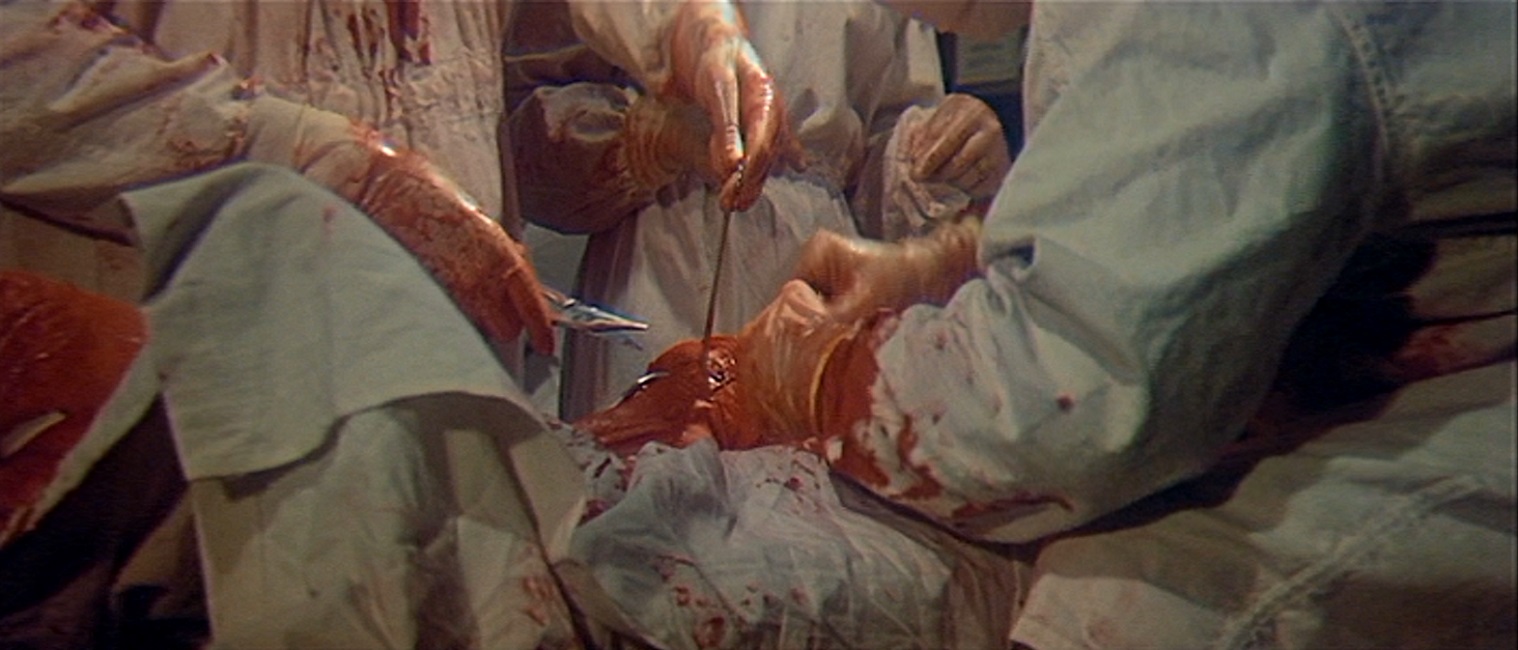
Another aspect of the Korean War were air strikes by the United States Navy off of aircraft carriers. There were two movies set on these floating cities, but the first released, October 26, 1952, "Flat Top", starring Sterling Hayden and Richard Carlson, was really not about Korea. It starts with the carrier off the coast of North Korea, but the plot is a flash back to World War 2.
The one actual motion picture about a Naval Aircraft carrier during Korea was "Men of the Fighting Lady". The film was released May 7, 1954 after the war had ended.
The screenplay was inspired by two stories in "The Saturday Evening Post". One was by Navy Commander Harry A. Burns entitled "The Case of the Blinded Pilot". The true story about a pilot saving the life of another who was blinded in action. By talking him down to a safe landing on the flight deck of an aircraft carrier. The second story was by author James A. Michener, "Hawaii" and "Centennial", entitled "The Forgotten Heroes of Korea".
Above, actor Louis Calhern portraying James A. Michener, shakes the hand of Walter Pidgeon, playing "Commander Kent Downing". The screenplay has Michener visiting the aircraft carrier U.S.S. Oriskany CV-34 and is told a stories about life on board the ship, including the blinded pilot incident.
In 1956 a book was released that became an instant best seller. It was the autobiography of Dean Hess a pilot in Korea who started an orphanage during the war.
Universal Studios acquired the rights to the book and on February 14, 1957 the feature film "Battle Hymn", the autobiography's title, was released starring Rock Hudson as Dean Hess.
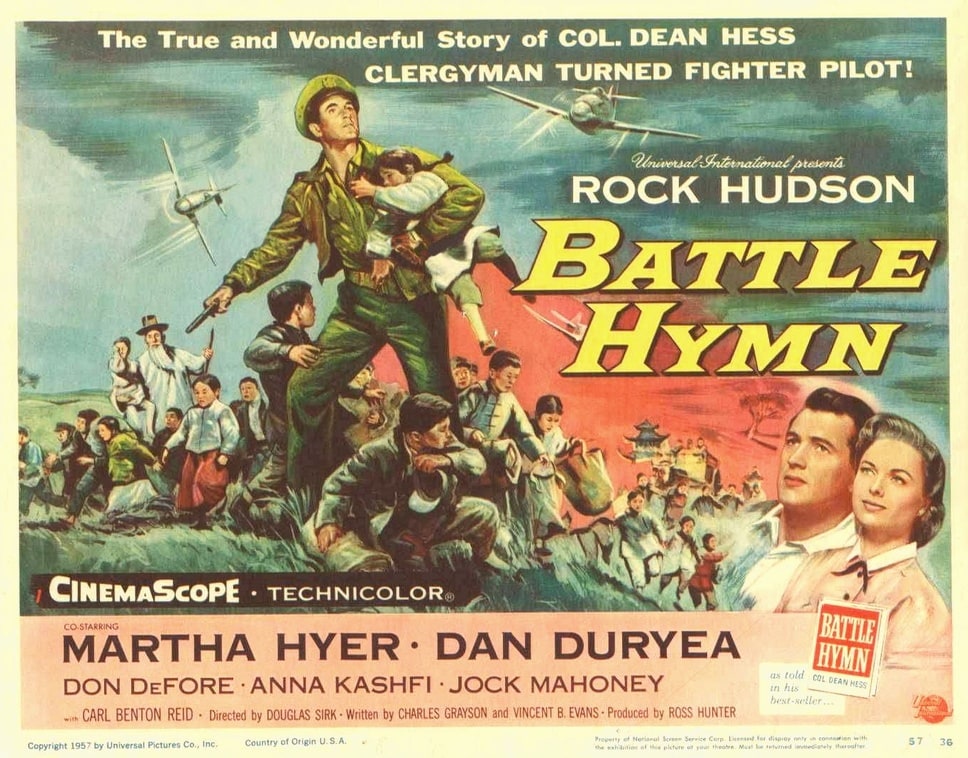
There were some changes in the screenplay by Vincent B. Evans and Charles Grayson to keep Hess's story within the running time of 108 minutes. One involved the women who would be in charge of the orphanage Hess sets up. In the movie she is named "En Soon Yang" and portrayed by Anna Kashfi an Indian actress as half Korean. The real full Korean "Oh Soon Whang" was actually 50 years of age at the time and not 23 the age of the actress.
Prior to World War 2 Dean Hess was a minister in Ohio.
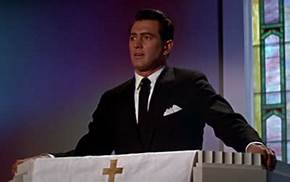
When the war started he joined the Army Air Force not as a minister, but a fighter pilot.
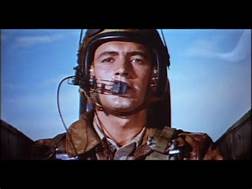
Above Rock Hudson and below the real Dean Hess
In 1956 a book was released that became an instant best seller. It was the autobiography of Dean Hess a pilot in Korea who started an orphanage during the war.
Universal Studios acquired the rights to the book and on February 14, 1957 the feature film "Battle Hymn", the autobiography's title, was released starring Rock Hudson as Dean Hess.

There were some changes in the screenplay by Vincent B. Evans and Charles Grayson to keep Hess's story within the running time of 108 minutes. One involved the women who would be in charge of the orphanage Hess sets up. In the movie she is named "En Soon Yang" and portrayed by Anna Kashfi an Indian actress as half Korean. The real full Korean "Oh Soon Whang" was actually 50 years of age at the time and not 23 the age of the actress.
Prior to World War 2 Dean Hess was a minister in Ohio.
When the war started he joined the Army Air Force not as a minister, but a fighter pilot.
Above Rock Hudson and below the real Dean Hess
On a mission in Germany Army Air Force Pilot Hess mistakenly bombed an orphanage that killed 37 orphans. This had an affect on him. When Korea started Hess became a flight instructor for the now United States Air Force. He was assigned to teach South Korean pilots. While this was occurring he discovered the plight of Korean orphans. This would lead to the establishment of one of the biggest orphanages in South Korea as he trained their air force.

James A. Michener wrote a group of stories under the collective title of "Tales of the South Pacific", These short stories became Rodgers and Hammerstein's musical "South Pacific". A 1954 novel became a feature film released December 5, 1957 under its title of "Sayonara". The movie starred Marlon Brando as "Major Lloyd 'Ace' Gruver" of the United States Air Force. Both Red Button as "Airman Joe Kelly" and Japanese actress Miyoshi Umeki as "Katsumi" won the Oscars for Best Supporting Actor and Actress.
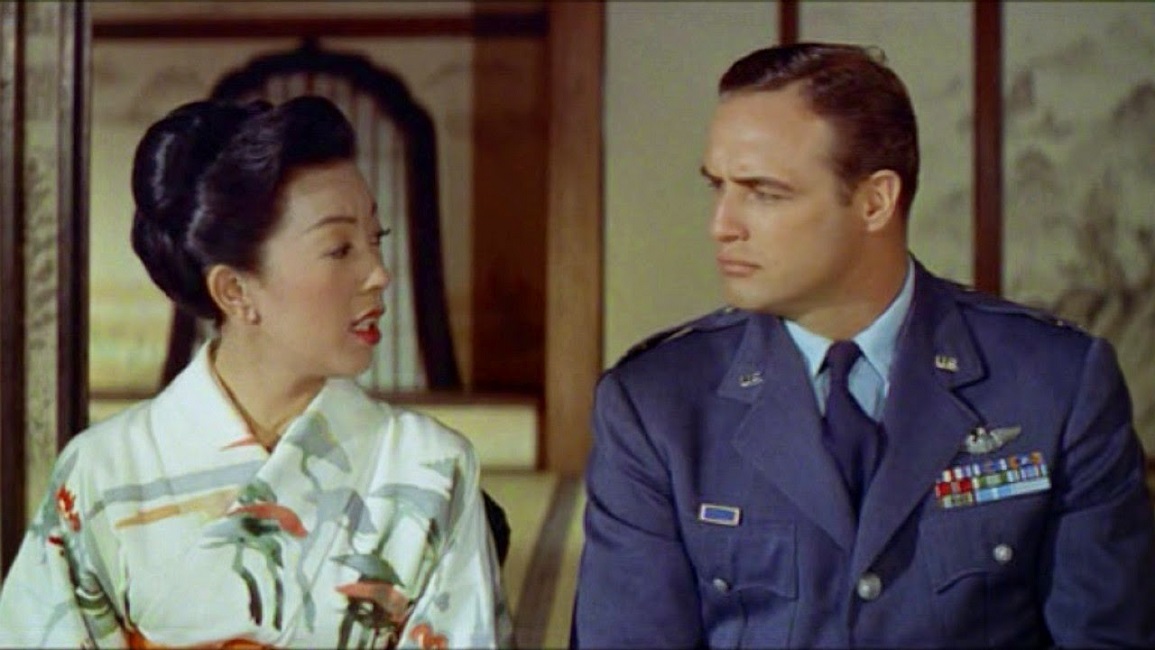
Above Marlon Brando and Miiko Taka
Below Red Button and Miyoshi Umeki

The two Oscar winners characters fall in love and marry. Today this would seem normal, but when the novel came out in 1954 and the motion picture three years later. The idea of an interracial love story and especially a marriage was taboo. Add to the fact the story takes place during the Korean War and involves an American airman with a Japanese women was shocking.
My reader has to remember there were a lot of hard feelings in the United States still toward Japan from World War 2 and the reverse in Japan. The American Occupation of Japan technically ended only in 1952 two years after Korea had began and two years before Michener wrote "Sayonara" .
"Joe" and "Katsumi's" love story ends in tragedy with a double suicide over how the two are being treated by both Americans and Japanese. In the novel this leads to laws being passed permitting marriage between Americans and Japanese.
In reality the United States Armed Forces had not considered that American Service Men might actually want to marry Japanese women. Eventually they had to address this and laws were amended to permit such marriages.
The main love story was between Brando's "Major Lloyd Gruver" and a Japanese entertainer "Hana-ogi" portrayed by Miiko Taka. Initially "Gruver" is brought out of combat, because he was engaged to a General's daughter. This will also reflect the prejudice between Americans and Japanese. In the end Brando leaves his fiancee for the women he really loves.
The final motion picture I will look at is "Pork Chop Hill" released May 29, 1959 and directed by the great Lewis Milestone
On April 21, 1930 director Lewis Milestone's "All Quiet on the Western Front" was released in Los Angeles. This was the motion picture adaptation of German author Eric Maria Remarque's 1929 novel. |
The story is about German youth being taken out of their peaceful home life and school settings to become soldiers of the Kaiser. Fighting for Germany during World War One, but on leave they find themselves out of touch with the life they previously led and the people they knew.
Lewis Milestone's motion picture went further than the novel and created two things. A look at what happens to innocents during a war and a major anti-war film that is still viewed as such today.
Milestone was given the responsibility by producer Sy Bartlett to turn S.L.A. Marshall's 1956 novel "Pork Chop Hill: The American Fighting Man in Action" into a motion picture. The result is a vivid look at the futility of war and once again its affects on the soldier. In this case the issue is taking one hill from the Chinese over and over again for no apparent real reason. Other than keeping them from having it.
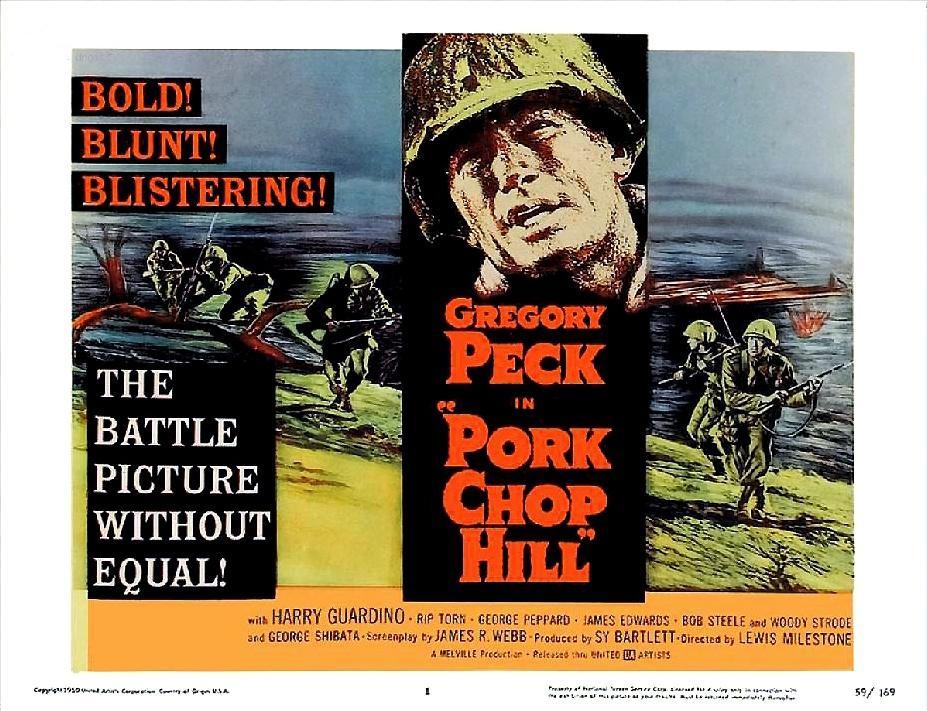
The screenplay was by James R. Webb and he did an excellent job blending grim battles, racism within the American Army and the ridiculousness of the "Peace Talks".
The battle for Pork Chop Hill was real and actor Gregory Peck portrayed the real life Lieutenant Joseph 'Joe" Clemens.

James A. Michener wrote a group of stories under the collective title of "Tales of the South Pacific", These short stories became Rodgers and Hammerstein's musical "South Pacific". A 1954 novel became a feature film released December 5, 1957 under its title of "Sayonara". The movie starred Marlon Brando as "Major Lloyd 'Ace' Gruver" of the United States Air Force. Both Red Button as "Airman Joe Kelly" and Japanese actress Miyoshi Umeki as "Katsumi" won the Oscars for Best Supporting Actor and Actress.

Above Marlon Brando and Miiko Taka
Below Red Button and Miyoshi Umeki

The two Oscar winners characters fall in love and marry. Today this would seem normal, but when the novel came out in 1954 and the motion picture three years later. The idea of an interracial love story and especially a marriage was taboo. Add to the fact the story takes place during the Korean War and involves an American airman with a Japanese women was shocking.
My reader has to remember there were a lot of hard feelings in the United States still toward Japan from World War 2 and the reverse in Japan. The American Occupation of Japan technically ended only in 1952 two years after Korea had began and two years before Michener wrote "Sayonara" .
"Joe" and "Katsumi's" love story ends in tragedy with a double suicide over how the two are being treated by both Americans and Japanese. In the novel this leads to laws being passed permitting marriage between Americans and Japanese.
In reality the United States Armed Forces had not considered that American Service Men might actually want to marry Japanese women. Eventually they had to address this and laws were amended to permit such marriages.
The main love story was between Brando's "Major Lloyd Gruver" and a Japanese entertainer "Hana-ogi" portrayed by Miiko Taka. Initially "Gruver" is brought out of combat, because he was engaged to a General's daughter. This will also reflect the prejudice between Americans and Japanese. In the end Brando leaves his fiancee for the women he really loves.
The final motion picture I will look at is "Pork Chop Hill" released May 29, 1959 and directed by the great Lewis Milestone
On April 21, 1930 director Lewis Milestone's "All Quiet on the Western Front" was released in Los Angeles. This was the motion picture adaptation of German author Eric Maria Remarque's 1929 novel. |
The story is about German youth being taken out of their peaceful home life and school settings to become soldiers of the Kaiser. Fighting for Germany during World War One, but on leave they find themselves out of touch with the life they previously led and the people they knew.
Lewis Milestone's motion picture went further than the novel and created two things. A look at what happens to innocents during a war and a major anti-war film that is still viewed as such today.
Milestone was given the responsibility by producer Sy Bartlett to turn S.L.A. Marshall's 1956 novel "Pork Chop Hill: The American Fighting Man in Action" into a motion picture. The result is a vivid look at the futility of war and once again its affects on the soldier. In this case the issue is taking one hill from the Chinese over and over again for no apparent real reason. Other than keeping them from having it.

The screenplay was by James R. Webb and he did an excellent job blending grim battles, racism within the American Army and the ridiculousness of the "Peace Talks".
The battle for Pork Chop Hill was real and actor Gregory Peck portrayed the real life Lieutenant Joseph 'Joe" Clemens.
Above Gregory Peck and below the real Joe Clemons.

The racism is addressed in the hard-hitting, realistic, motion picture and revolves around actors James Edwards, on the left of the following still, and Woody Strode on the right. Edwards' "Corporal Jurgens" is proud and wants to prove a Negro soldier is as good as a White one. While Strode's "Private Franklin" is the opposite and interested in saving his own skin.

The racism is addressed in the hard-hitting, realistic, motion picture and revolves around actors James Edwards, on the left of the following still, and Woody Strode on the right. Edwards' "Corporal Jurgens" is proud and wants to prove a Negro soldier is as good as a White one. While Strode's "Private Franklin" is the opposite and interested in saving his own skin.
Both soldiers were part of "24th Infantry Regiment" a basically still racially segregated regiment, at the time of Korea, founded in 1869 after the American Civil War ended. In 1951 the regiment was poorly trained, equipped and led by White Officers. It was felt the "Negroes" would run from the fighting and a decision by the Department of the Army was to break up the "24th" and spread these troops among other units. This was at the start of 1951.
I started this article with actual casualty figures. Here are the total losses on both sides over this truly insignificant hill:.
13 United States Army Company Commanders were killed. Total U.S. Casualties were 243 killed, 916 wounded and 9 captured. Of those Killed in Action (KIA) 163 bodies were never recovered. The causalities for The Republic of Korea (South Korea) assigned to the Americans were 15 killed and 120 wounded. The Chinese causalities were estimated as 1,500 dead and 4,000 wounded.
Three weeks after the conclusion of the final battle for Pork Chop Hill, depicted in the motion picture, the armistice was signed. William Tecumseh Sherman said during the American Civil War that;
So was something called a:
I started this article with actual casualty figures. Here are the total losses on both sides over this truly insignificant hill:.
13 United States Army Company Commanders were killed. Total U.S. Casualties were 243 killed, 916 wounded and 9 captured. Of those Killed in Action (KIA) 163 bodies were never recovered. The causalities for The Republic of Korea (South Korea) assigned to the Americans were 15 killed and 120 wounded. The Chinese causalities were estimated as 1,500 dead and 4,000 wounded.
Three weeks after the conclusion of the final battle for Pork Chop Hill, depicted in the motion picture, the armistice was signed. William Tecumseh Sherman said during the American Civil War that;
WAR IS HELL!
So was something called a:
A POLICE ACTION



















